Senegal is a country in West Africa that is home to a variety of bird species. From colorful parrots to majestic raptors, Senegal’s avian population is diverse and fascinating.
Many of these birds are endemic to the region, making them a unique feature of Senegal’s natural beauty. In this article, we will explore some of Senegal’s most interesting birds and discuss their habitats, behavior, and conservation status.
1. Senegal Parrot
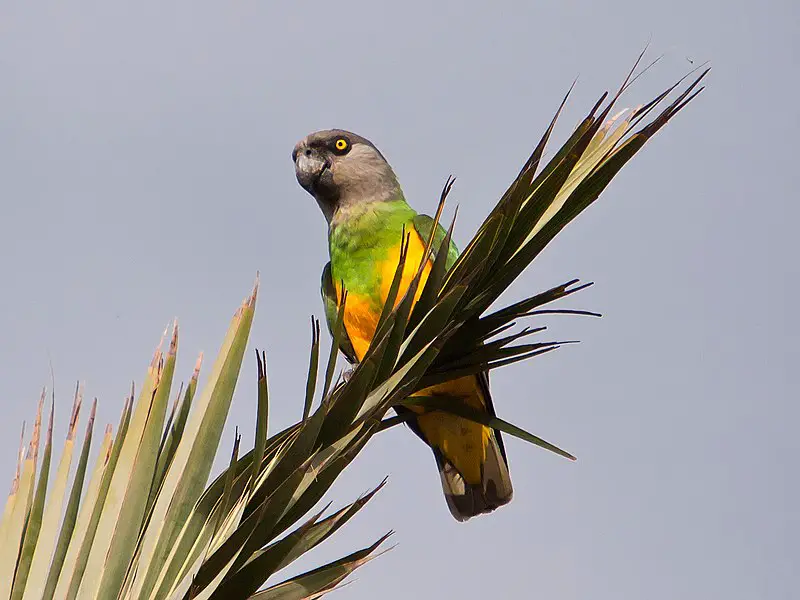
The Senegal Parrot is a resident breeder across West Africa, known for making migrations according to the availability of its diet. This mainly consists of fruit, seeds, and blossoms.
Unfortunately it has become quite the farm pest in Africa due to feeding on maize or millet crops.
Despite this however it remains popular among aviculture enthusiasts worldwide as an attractive pet bird that can learn tricks easily and mimics sounds well.
It was first described by French zoologist Mathurin Jacques Brisson in 1760 with some subspecies also being recognized since then leading up until today’s modern understanding of them all together.Scientific classification:
| Kingdom | Animalia |
| Phylum | Chordata |
| Class | Aves |
| Order | Psittaciformes |
| Family | Psittacidae |
| Genus | Poicephalus |
| Species | P. senegalus |
Also Featured In: Case Birds that Live in with Us,
2. Poicephalus
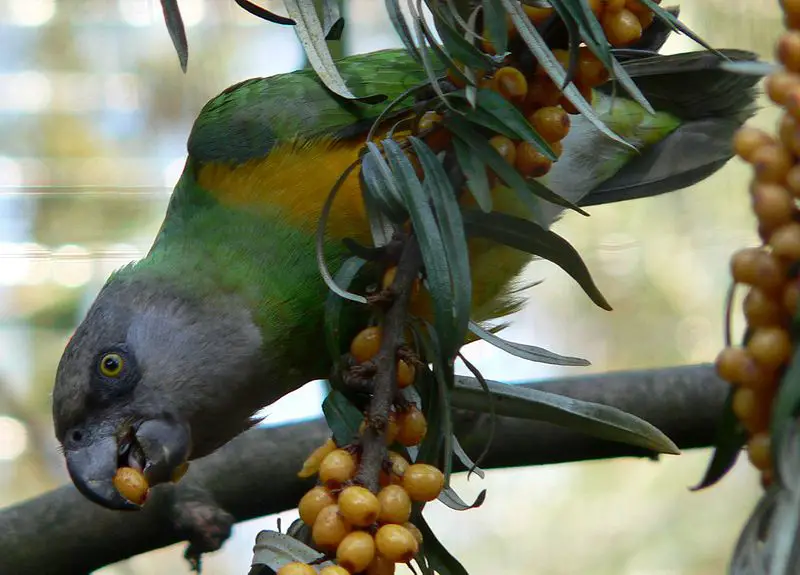
Poicephalus is a genus of parrots native to Sub-Saharan Africa that belongs to the subfamily Psittacinae. It comprises ten species which are found from Senegal in West Africa all the way down South Africa.
These birds have short tails and mainly green plumage, with some species having different colors such as yellow or blue on their breast and wings feathers.
They are mostly medium-sized (around 10 inches) but can vary depending on the specie, ranging from 6 – 15 inches long.
Poicephalus parrots tend to be very active and social animals, making them great pets for people who enjoy spending time interacting with their feathered friends.
They require daily stimulation through playtime, cuddles, toys or even talking sessions so they can stay mentally engaged throughout their lives.Scientific classification:
| Kingdom | Animalia |
| Phylum | Chordata |
| Class | Aves |
| Order | Psittaciformes |
| Family | Psittacidae |
| Subfamily | Psittacinae |
| Genus | Poicephalus Swainson, 1837 |
Also Featured In: Aviary Birds You Should Know,
3. Meyer’s Parrot
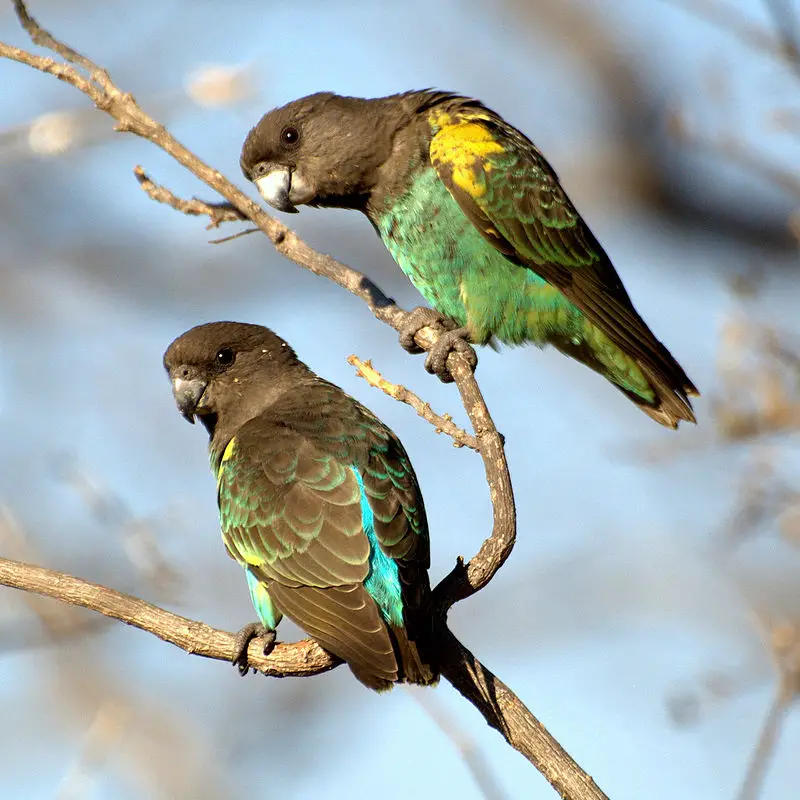
Meyer’s parrot is a species of African parrot with grey feathers, turquoise belly and blue rump. It also has yellow markings on the carpal joint of its wings and some subspecies have additional yellow coloring on their heads.
There are six recognized subspecies that vary in terms of home range, size and markings.
Meyer’s parrots can be found in many countries across Africa including Kenya, Ethiopia, Somalia and Tanzania where they prefer to reside amongst acacia trees near rivers or streams.
They typically feed off fruits such as figs as well as seeds from grasses and herbs which makes them incredibly important for maintaining biodiversity levels in these areas.Scientific classification:
| Kingdom | Animalia |
| Phylum | Chordata |
| Class | Aves |
| Order | Psittaciformes |
| Family | Psittacidae |
| Genus | Poicephalus |
| Species | P. meyeri |
4. Hornbill
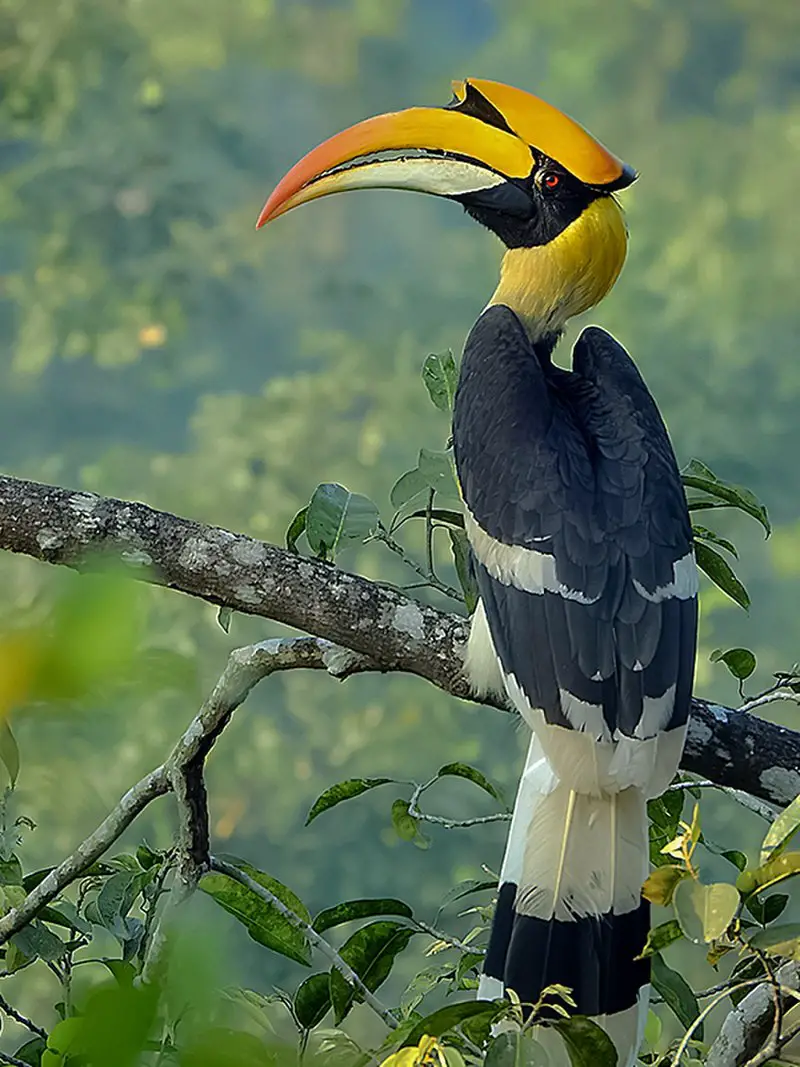
Hornbills are a tropical and subtropical bird species with characteristic long, curved bills. Their English and scientific names both refer to the shape of their bill which resembles that of a cow’s horn.
They have strong beaks for cracking open hard-shelled fruits as well as powerful wings for flying between trees or over great distances in search of food or mates.
Hornbills also feature beautiful plumage ranging from white to black feathers with yellow, brown, red and blue accents on the head, neck and back areas depending on the species.
In addition they often display brightly coloured casques – helmet like structures – atop their upper mandible adding further visual appeal to these majestic birds.Scientific classification:
| Kingdom | Animalia |
| Phylum | Chordata |
| Class | Aves |
| Order | Bucerotiformes |
| Family | Bucerotidae Rafinesque, 1815 |
5. Hamerkop
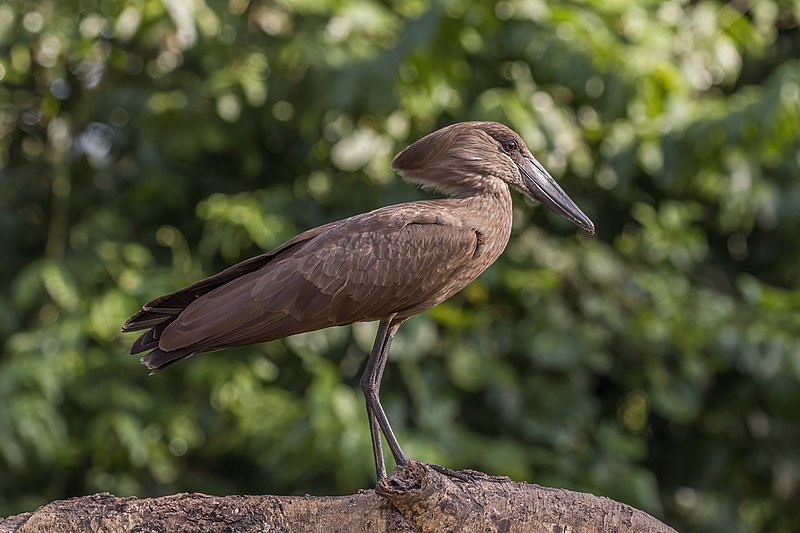
The Hamerkop is a unique wading bird found across sub-Saharan Africa and as far east as India.
It has an unmistakable silhouette, with its long bill topped by a crest at the back of its head that gives it the look of a hammerhead shark.
Its plumage consists mainly of browns and greys, providing excellent camouflage in reed beds.
The species was once classified alongside storks but is now believed to be closely related to pelicans and shoebills instead.
This medium-sized bird feeds on insects, fish, frogs or small reptiles which it captures from shallow water or plucks from trees near bodies of water.
Despite being considered ‘unlucky’ by some cultures due to superstition surrounding their appearance they are actually quite important for controlling populations of certain pests.Scientific classification:
| Kingdom | Animalia |
| Phylum | Chordata |
| Class | Aves |
| Order | Pelecaniformes |
| Family | Scopidae |
| Genus | Scopus |
| Species | S. umbretta |
6. Turaco
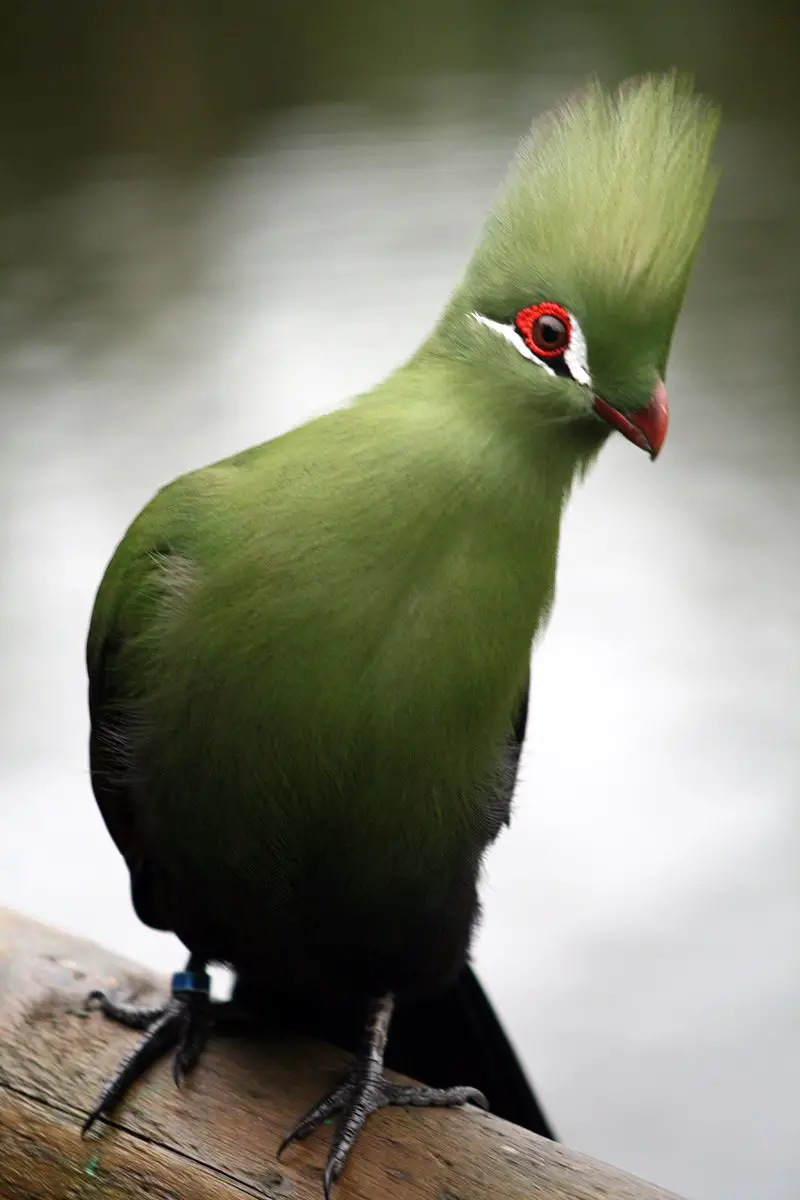
Turacos are a unique bird family that inhabit tropical and subtropical regions of Africa. They are also known as “banana-eaters” or “loeries” in southern Africa, due to their diet which consists mostly of fruit such as plantains.
These birds have an interesting semi-zygodactylous foot structure – the fourth toe can be switched back and forth while the second and third toes remain conjoined.
Turacos come in different sizes depending on species but they all generally boast bright colors like green, blue, purple or red feathers with vibrant yellow eyes.
In addition to being beautiful creatures, these birds make loud calls during mating season which makes them even more special.Scientific classification:
| Kingdom | Animalia |
| Phylum | Chordata |
| Class | Aves |
| Clade | Otidimorphae |
| Order | Musophagiformes Seebohm, 1890 |
| Family | Musophagidae Lesson, 1828 |
7. Bustard
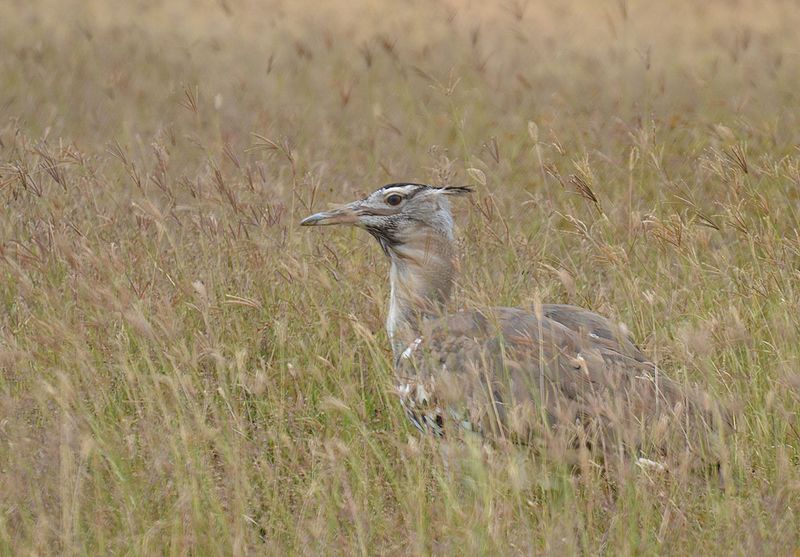
Bustards are large, terrestrial birds that inhabit dry grassland areas and the steppes of the Old World. They range from 40-150 cm in length and belong to the family Otididae.
Bustards have an omnivorous diet consisting of leaves, buds, seeds, fruit as well as small vertebrates and invertebrates.
These birds usually live a solitary life but can be seen gathering around water sources or food during certain times of year such as mating season.
Due to their large size they are vulnerable to predation by foxes or other animals which is why they tend to remain alert at all times.
When in open spaces while relying on camouflage for protection against predators when out in tall vegetation coverings.Scientific classification:
| Kingdom | Animalia |
| Phylum | Chordata |
| Class | Aves |
| Clade | Otidimorphae |
| Order | Otidiformes Wagler, 1830 |
| Family | Otididae Rafinesque, 1815 |
8. Stone-Curlew

Stone-curlews, also known as dikkops or thick-knees, are a family of birds that have adapted to live in tropical and temperate regions throughout the world.
They can be found in Africa, Asia and Australia with two or more species per region. Despite being classified as waders, most prefer dry arid habitats over moist wetlands.
Stone-curlews typically have long legs which help them navigate through their preferred terrain efficiently; some species even stand at an impressive height when standing on those long legs.
Additionally they feature cryptic plumage which helps them blend into their surroundings while hunting for prey such as insects and small mammals like rodents.
These unique bird’s calls are easily recognizable; it has been said that hearing one is similar to listening to someone whistling ‘Keee Weee’.Scientific classification:
| Kingdom | Animalia |
| Phylum | Chordata |
| Class | Aves |
| Order | Charadriiformes |
| Suborder | Chionidi |
| Family | Burhinidae Mathews, 1912 |
9. Swallows
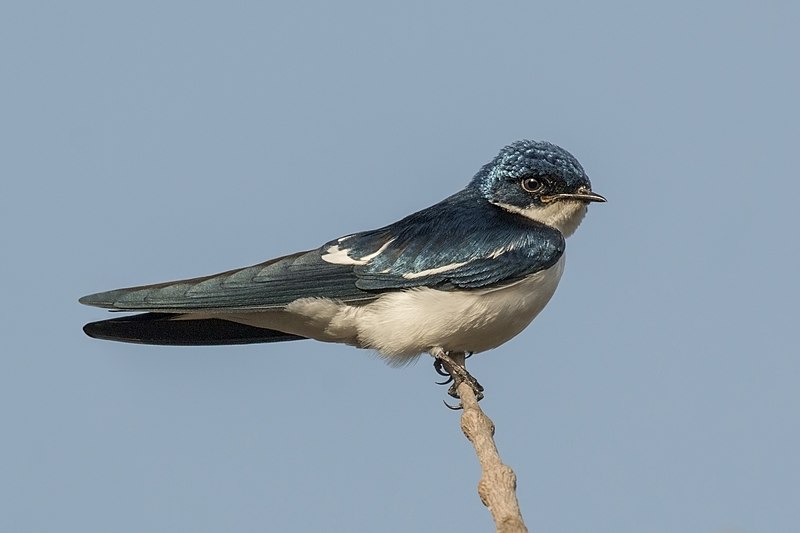
Swallows are small songbirds found around the world on all continents, even Antarctica. They have a distinctive appearance and are highly adapted to aerial feeding with their long wings and forked tail.
There is an estimated 90 species of swallows in 19 different genera, making them one of the most widespread bird families on earth.
The barn swallow is perhaps the most well-known species among these birds due to its presence near human settlements across Europe; they’re so ubiquitous that “swallow” has become synonymous with this particular type of bird there.
Swallows also play important roles in ecology as insectivores; some species migrating vast distances every year between summer breeding grounds and wintering locations.Scientific classification:
| Kingdom | Animalia |
| Phylum | Chordata |
| Class | Aves |
| Order | Passeriformes |
| Suborder | Passeri |
| Family | Hirundinidae Rafinesque, 1815 |
10. Gulls
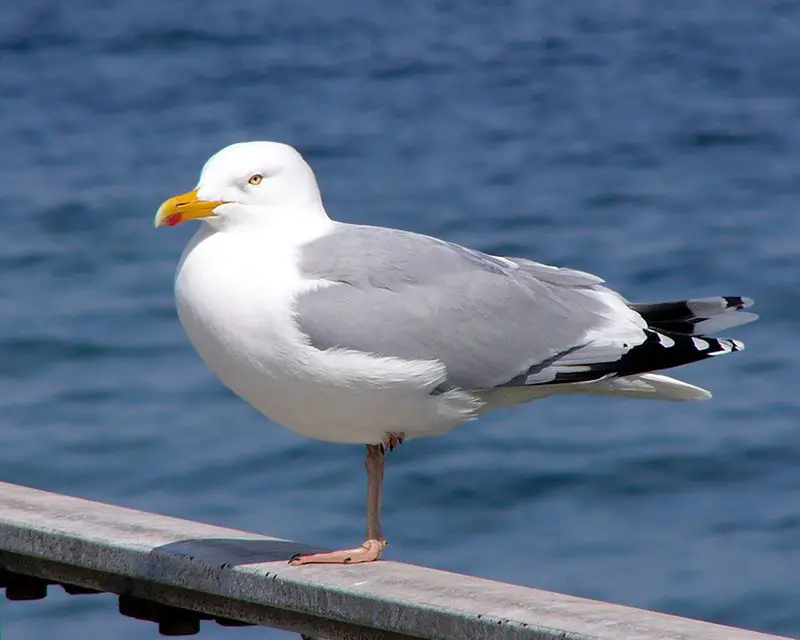
Gulls are a type of seabird in the family Laridae found worldwide. They are highly adaptable, often seen soaring above shorelines or near bodies of water.
Gulls have strong wings and long bills and vary greatly in size, colouration and behaviour from one species to another.
Some gull species feed on fish while others scavenge for food such as insects, small mammals or discarded human refuse.
Despite their different dietary habits they all share common traits including webbed feet which enable them to swim gracefully through the water after prey items like crabs or molluscs.
Gulls generally nest close to the shoreline where there is an abundance of available food sources making them excellent hunters that can live comfortably both on land and at sea.Scientific classification:
| Kingdom | Animalia |
| Phylum | Chordata |
| Class | Aves |
| Order | Charadriiformes |
| Suborder | Lari |
| Family | Laridae Rafinesque, 1815 |
11. Sandgrouse
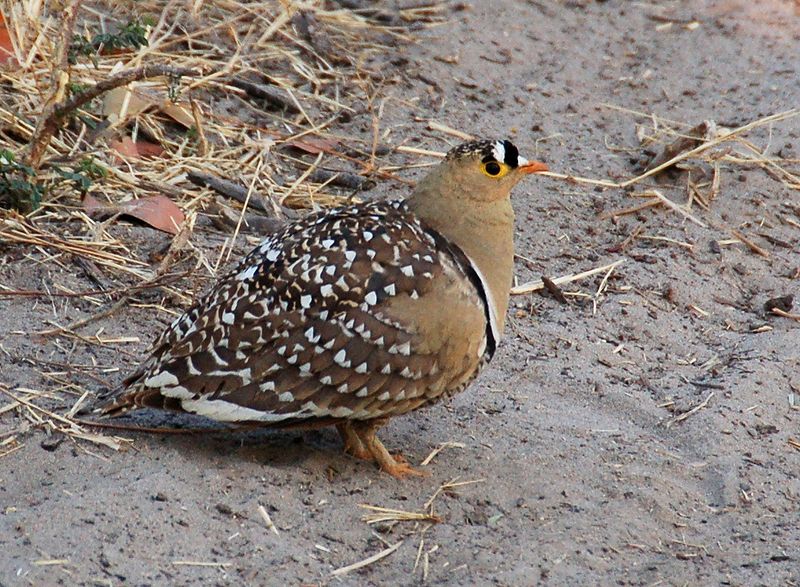
Sandgrouse is birds of the order Pterocliformes, found mainly in Africa and Asia. There are sixteen species belonging to two genera – Syrrhaptes from central Asia and Pterocles from Africa and other Asian countries.
They inhabit treeless areas such as deserts, steppes, scrubland, or savannas and tend to be ground-dwelling birds that feed on seeds.
Sandgrouse has adapted special features for survival in their harsh environment.
They possess well-developed feet with four toes used for walking over hot sand while keeping their body temperature cool at all times by regulating heat loss through their legs.
Their feathers also act like a sponge helping them absorb water before flying long distances back home where they then expel it using specialized glandular secretions located near the wings so that chicks can drink directly from an adult’s breast plumage.Scientific classification:
| Kingdom | Animalia |
| Phylum | Chordata |
| Class | Aves |
| Clade | Columbimorphae |
| Order | Pterocliformes Huxley, 1868 |
| Family | Pteroclidae Bonaparte, 1831 |
12. Hoopoes
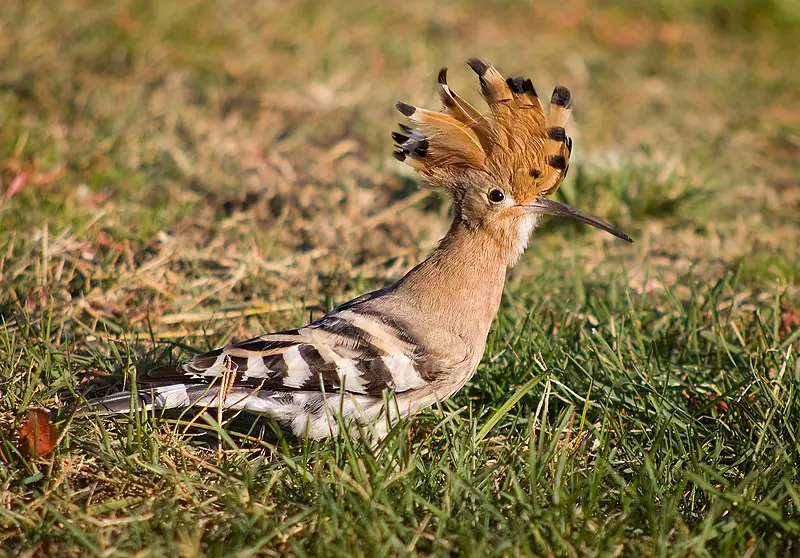
Hoopoes are a fascinating species of bird, found across Africa, Asia and Europe. They have beautiful plumage with unique ‘crowns’ of feathers on their heads.
Three living and one extinct species exist – although for some time they were all classed as the same species: Upupa epops. Some taxonomists still believe this to be true.
These birds are often associated with royalty due to the impressive crown-like crest atop their head, adding an extra element of mystery and exoticism to these creatures.
Hoopoes can also produce loud calls which sound like “hoo-poo” hence why they’ve been given such an apt name.Scientific classification:
| Kingdom | Animalia |
| Phylum | Chordata |
| Class | Aves |
| Order | Bucerotiformes |
| Family | Upupidae Leach, 1820 |
| Genus | Upupa Linnaeus, 1758 |
13. Jacanas
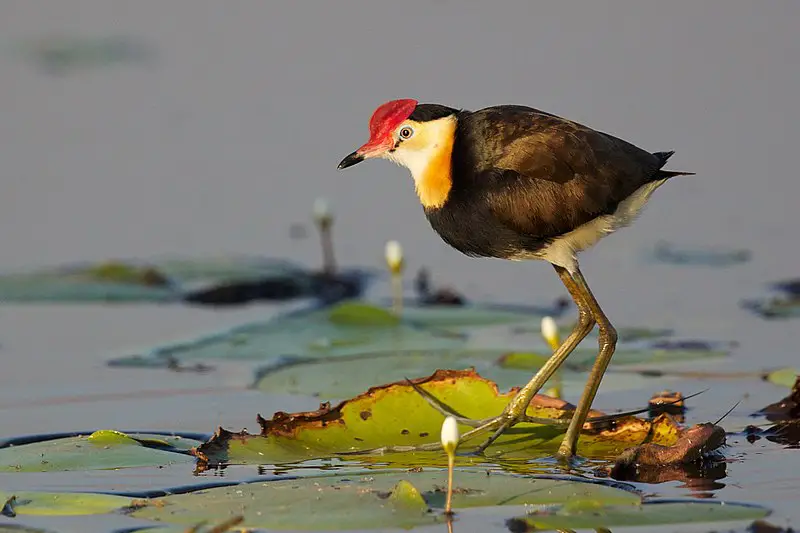
Jacanas are tropical waders belonging to the Jacanidae family. They have distinctive elongated toes and toenails which help them forage on floating or semi-emergent aquatic vegetation.
This adaptation gives them their nickname “Jesus birds” as they seem to be able to walk on water.
The female jacanas are also unique amongst bird species in that they take charge of nest building, incubation and caring for young while males perform courtship displays.
These unusual birds can be found throughout the world’s tropical regions where they inhabit wetlands such as swamps, marshes and shallow lakes with lily pads.
With a wide variety range due their special adaptations these beautiful creatures will surely continue living life at ease around our planet’s warmest waters.Scientific classification:
| Kingdom | Animalia |
| Phylum | Chordata |
| Class | Aves |
| Order | Charadriiformes |
| Suborder | Thinocori |
| Family | Jacanidae Stejneger, 1885 |
14. Heliornithidae
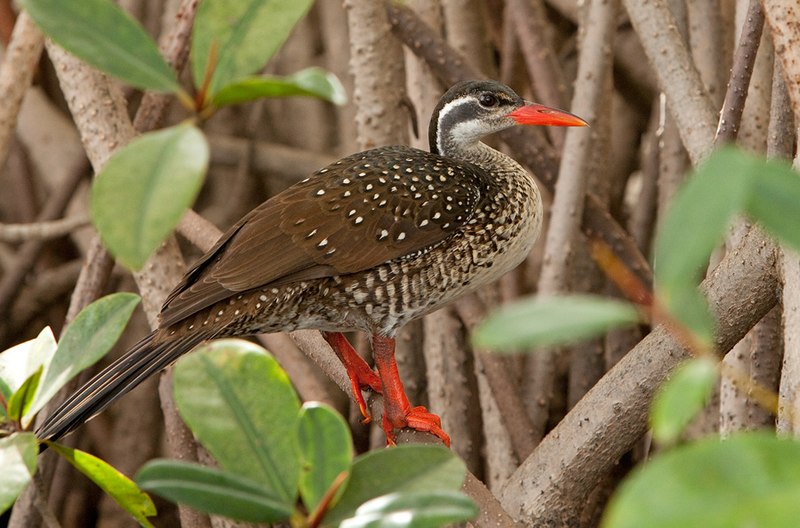
Heliornithidae, commonly known as finfoots, are a small family of tropical birds found in South America and Africa. They have webbed feet like grebes or coots, long necks, slender bodies and broad tails with sharp pointed bills.
Their diverse calls include whistles, squawks and croaks which they use to communicate with each other.
Finfoots feed mainly on fish but also consume insects such as water beetles and dragonflies near the surface of waterbodies.
They nest around rivers or lakes where there is plenty of cover from predators such as eagles or hawks.
During breeding season males can become quite territorial defending their territories against intruders by chasing them off aggressively using loud noises or even physical contact if necessary.Scientific classification:
| Kingdom | Animalia |
| Phylum | Chordata |
| Class | Aves |
| Order | Gruiformes |
| Family | Heliornithidae GR Gray, 1840 |
15. Plovers

Plovers are a family of around 64-68 species of ground-dwelling birds, commonly found in open country such as fields, meadows and tundras.
They have short bills with webbed feet to help them forage through mud or shallow water.
Plover plumage is usually mottled brown though some species may have brighter colors on the head and wings.
These birds feed mainly on insects but can also eat small crustaceans and worms.
Plovers breed during springtime when they dig holes in sandy or pebbled beaches to lay their eggs which hatch after about 3 weeks incubation period.
They use distraction display behaviour by pretending an injury to the predators away from their nests if needed for protecting their young ones.Scientific classification:
| Kingdom | Animalia |
| Phylum | Chordata |
| Class | Aves |
| Order | Charadriiformes |
| Family | Charadriidae Leach, 1820 |
16. Sunbird
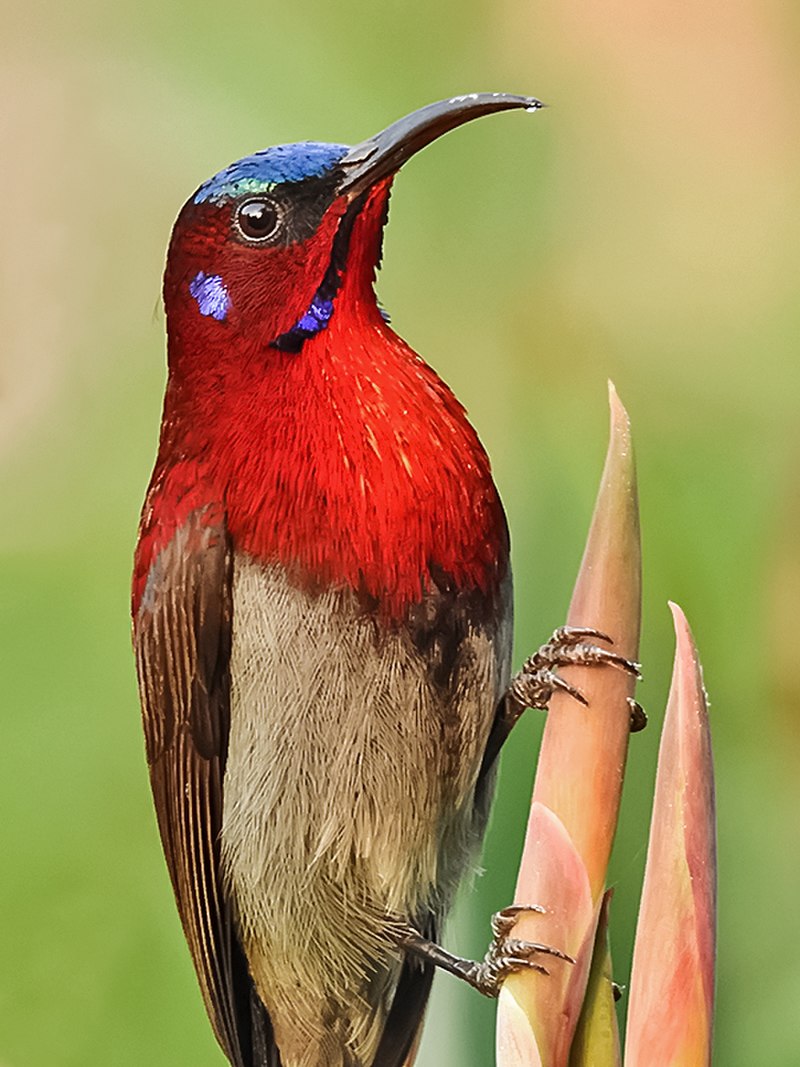
Sunbirds are a family of passerine birds known as the Nectariniidae, found mainly in Africa and parts of Asia. These small, slender birds have downward-curved bills and often feature brightly coloured iridescent feathers.
The males usually display longer tail feathers than females. Sunbird diets consist mostly of nectar from flowers which they sip using their long bill while hovering above them like hummingbirds do.
They also eat insects such as spiders and moths to supplement their nutrition needs.
Sunbirds can be seen flitting around gardens or parks looking for food sources – sometimes alone but more commonly in pairs or families during breeding season when they become quite territorial over an area where they feed on plants with abundant supplies of nectar.Scientific classification:
| Kingdom | Animalia |
| Phylum | Chordata |
| Class | Aves |
| Order | Passeriformes |
| Superfamily | Passeroidea |
| Family | Nectariniidae Vigors, 1825 |
17. Weavers
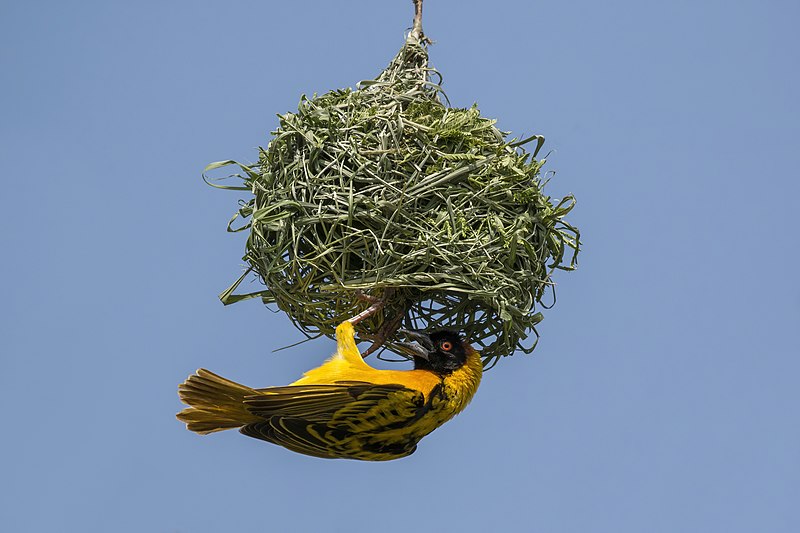
Weaver birds are small passerine birds found in the family Ploceidae. They are known for their intricately woven nests, made from vegetation and other materials sourced locally by the weavers.
These complex structures have earned them their distinctive name, as they appear to weave together a home away from home.
Weaverbirds come in a range of sizes and colours – some are brightly coloured while others may be more subtle or plainer looking – but all share an affinity with weaving material into intricate architectural designs.
Some species also use mud instead of plant life to build these impressive homes. Not only do these feathered architects give us insight into nature’s incredible capacity for problem-solving and resourcefulness; they provide stunningly colourful displays too.Scientific classification:
| Kingdom | Animalia |
| Phylum | Chordata |
| Class | Aves |
| Order | Passeriformes |
| Superfamily | Passeroidea |
| Family | Ploceidae Sundevall, 1836 |
18. White-Faced Whistling Duck
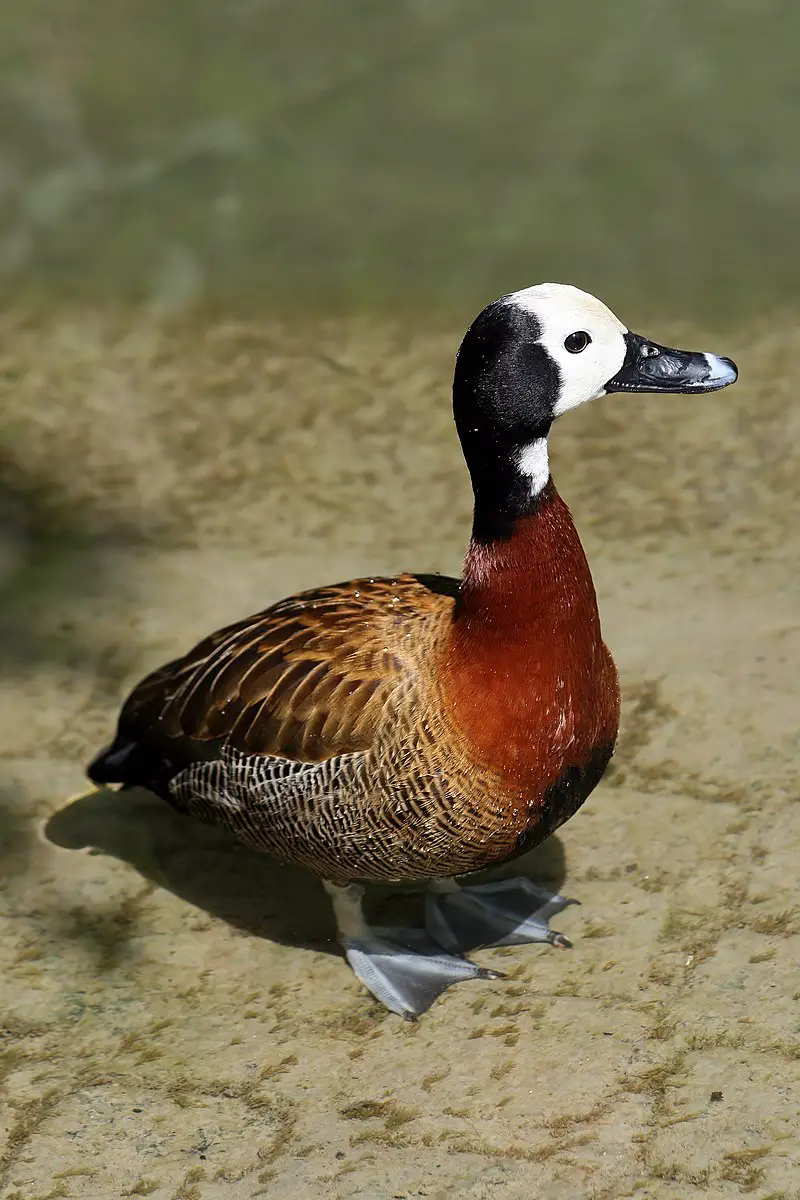
The white-faced whistling duck is a highly social bird native to sub-Saharan Africa and South America. It can be easily identified by its distinct three-note whistling call, as well as its long grey bill.
In the right conditions, it’s not uncommon to spot large flocks of these ducks numbering in the thousands at dawn – an incredible sight.
This species usually lives near bodies of water such as swamps or rivers where they feed on plant matter like grasses and grains which they graze on during the day.
When night falls, they fly off into trees nearby in search of safety from predators before returning to their feeding grounds when morning arrives again.Scientific classification:
| Kingdom | Animalia |
| Phylum | Chordata |
| Class | Aves |
| Order | Anseriformes |
| Family | Anatidae |
| Genus | Dendrocygna |
| Species | D. viduata |
19. Black-Throated Coucal
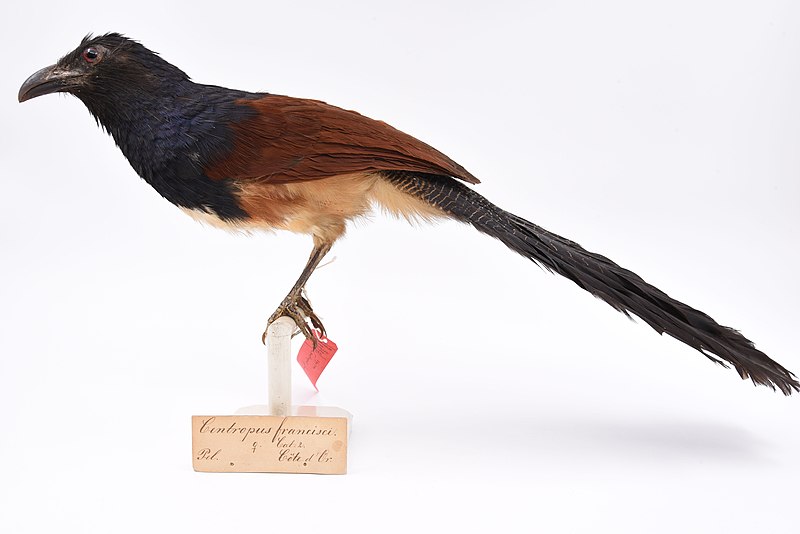
The Black-throated Coucal is a species of cuckoo found in dense second growth along forest edges and grassy swamps in West Africa. It is the largest bird within its genus, Centropus, with adults growing up to 46-58 cm long.
The black-throated coucal can be identified by its large size and dark grey feathers on top that contrast sharply against white underneath it’s wings and tail. Its strong legs are red or pinkish while its bill has an orange coloration.
In Northern and Central Zaire, there exists a separate subspecies called Neumann’s coucal which may eventually get split off as a distinct species due to their unique appearances such as more reddish plumage around the neck area instead of grey like other members of this family have.Scientific classification:
| Kingdom | Animalia |
| Phylum | Chordata |
| Class | Aves |
| Order | Cuculiformes |
| Family | Cuculidae |
| Genus | Centropus |
| Species | C. leucogaster |
20. Bronze Mannikin
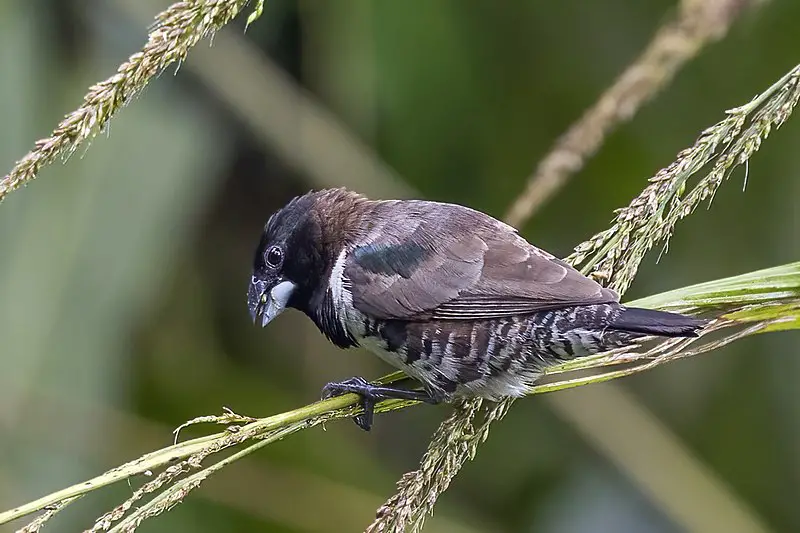
The Bronze Mannikin is a small passerine bird that lives in the Afrotropic region. It’s an uncommon to locally abundant species found south of the Sahara Desert, usually inhabiting mesic savanna or forest margins.
With its estimated 8,100,000 km2 global range of occurrence, it can be quite common in some places and rare in others.
This social finch loves being around people and other birds; it even has been known to join mixed flocks alongside larks and pipits.
Its vibrant feathers make for a stunning sight as it perches on tree branches singing joyfully throughout the day.Scientific classification:
| Kingdom | Animalia |
| Phylum | Chordata |
| Class | Aves |
| Order | Passeriformes |
| Family | Estrildidae |
| Genus | Spermestes |
| Species | S. cucullata |
21. Village Indigobird
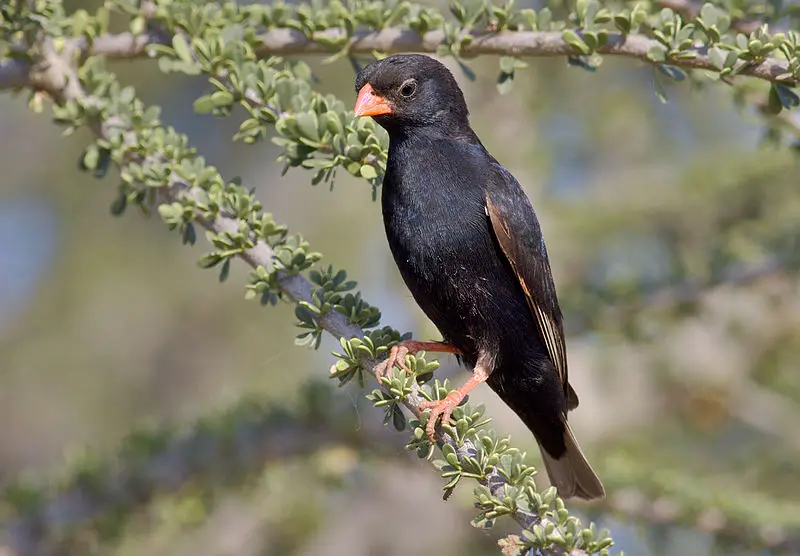
The Village Indigobird is a small songbird belonging to the family Viduidae, easily distinguishable from other indigobirds by their bill and leg colour.
The male’s breeding plumage also has an interesting tinge of colour that sets it apart. Moreover, its unique song and nestling’s plumage add to the bird’s distinctiveness.
It can be found in parts of Africa such as Cameroon or Ghana where they often occur near villages or cultivated areas like bushland edges.
Despite being quite common, these birds are vulnerable due to habitat loss which makes them important conservation efforts should focus on protecting their natural habitats so that this species can continue thriving for generations to come.Scientific classification:
| Kingdom | Animalia |
| Phylum | Chordata |
| Class | Aves |
| Order | Passeriformes |
| Family | Viduidae |
| Genus | Vidua |
| Species | V. chalybeata |
22. White-Billed Buffalo Weaver
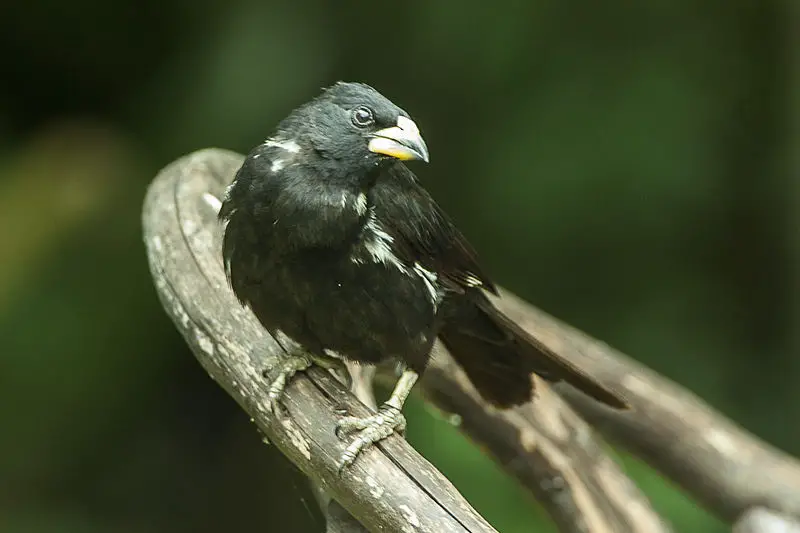
The White-billed Buffalo Weaver is a species of bird found south of the Sahara Desert in Africa. It can often be spotted near open fields and scrubland, living as part of communal colonies that build massive untidy nests high up in trees.
The spherical woven nests each house two to four eggs during breeding season. This buff colored weaver has black wings with white undersides, and its most distinguishing feature is its white curved bill which gives it its name.
Although they are relatively common across much of their range, overgrazing by livestock may pose a threat to this rarely studied species in some areas.Scientific classification:
| Kingdom | Animalia |
| Phylum | Chordata |
| Class | Aves |
| Order | Passeriformes |
| Family | Ploceidae |
| Genus | Bubalornis |
| Species | B. albirostris |
23. Austral Storm Petrels
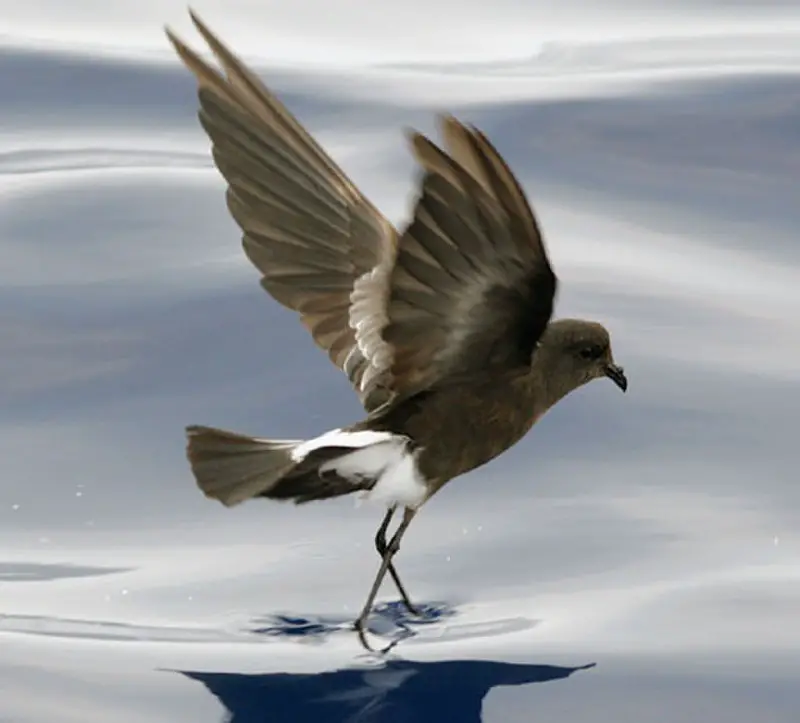
Austral Storm Petrels are the smallest of seabirds, belonging to the family Oceanitidae and order Procellariiformes.
They have a cosmopolitan distribution across all oceans, with their flight being fluttering and sometimes bat-like in appearance.
These birds feed on planktonic crustaceans as well as small fish that they pick from the surface while hovering over it.
Their plumage is mostly dark grey or blackish brown above; underparts may be white or mottled gray.
The feet vary between species but usually have pale yellow webs and claws which help them move easily through water when searching for food.
Austral storm petrels often make nests on remote islands where these birds can breed safely without any disturbances from humans during their nesting season.Scientific classification:
| Kingdom | Animalia |
| Phylum | Chordata |
| Class | Aves |
| Order | Procellariiformes |
| Family | Oceanitidae Forbes, 1881 |
24. Psittaculidae
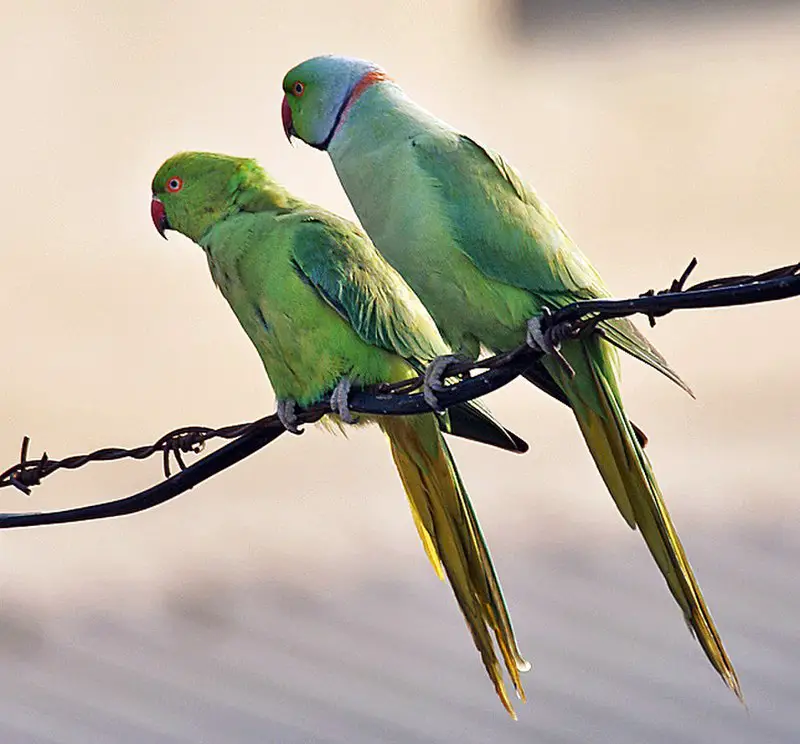
Psittaculidae is a family of Old World parrots that consists of five subfamilies. It includes 192 species divided into 53 genera, and has been accepted by the Clements Checklist of Birds as well as IOC World Bird List.
These birds are known for their bright colours, strong beaks and powerful vocalisations. They can also mimic human sounds including words when taught properly with patience and consistency.
They live in warm climate regions such as Africa, Asia Pacific Islands, Australia and Oceania where they enjoy plentiful food sources like fruits, nuts and seeds in abundance.
Psittaculids are typically found living in groups or pairs instead of alone because they enjoy socialising with others from within their own kind.Scientific classification:
| Kingdom | Animalia |
| Phylum | Chordata |
| Class | Aves |
| Order | Psittaciformes |
| Superfamily | Psittacoidea |
| Family | Psittaculidae Vigors, 1825 |
25. Little Bee-Eater
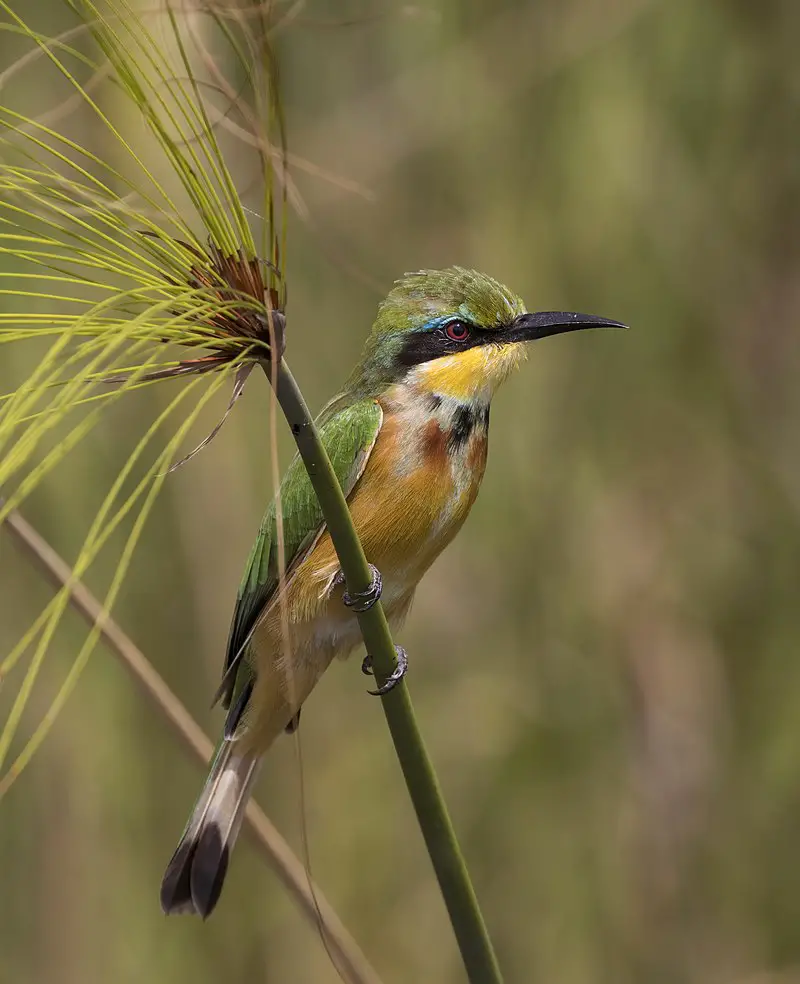
The Little Bee-eater (Merops pusillus) is a beautiful species of bird belonging to the family Meropidae.
These birds are found in much of Sub-Saharan Africa and their migration patterns depend on seasonal rainfall changes.
They have slender, brightly coloured bodies with an iridescent green sheen across the wings and back.
Their diet consists mainly of bees, wasps, dragonflies, moths and other insects which they catch mid-air or from perches above open grasslands or along mudbanks near water sources like rivers and lakes.
In order for these birds to digest their food properly before swallowing it whole, they use pebbles that help them grind up hard exoskeletons so as not to cause any blockages within their digestive tract – something only bee-eaters do.Scientific classification:
| Kingdom | Animalia |
| Phylum | Chordata |
| Class | Aves |
| Order | Coraciiformes |
| Family | Meropidae |
| Genus | Merops |
| Species | M. pusillus |
26. White-Backed Vulture
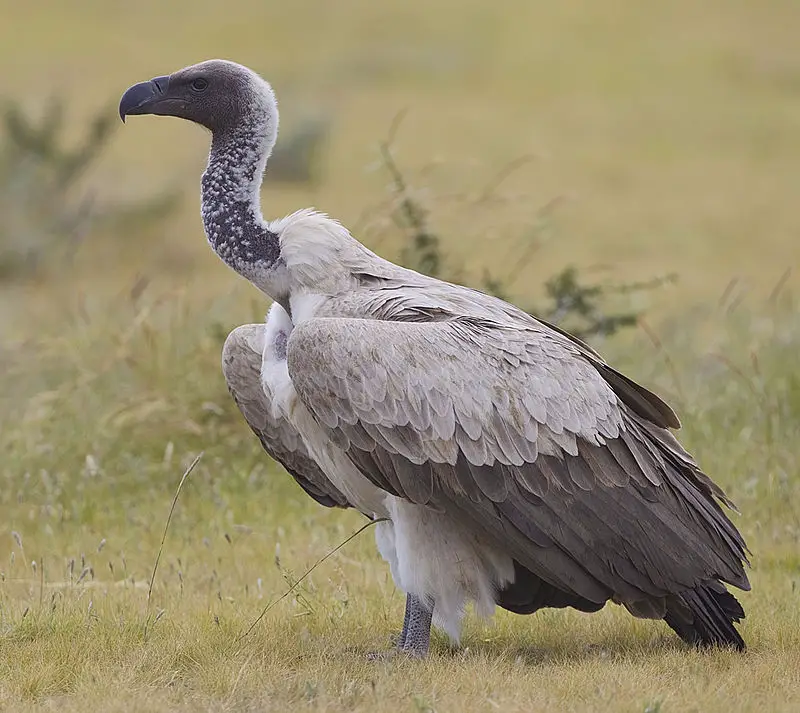
The White-backed Vulture, or Gyps africanus, is a species of Old World vultures that inhabits the African continent.
It has distinct features including down feathers on its head and neck as well as white ruff around its neck. Its wings are broad and its tail short.
This distinctive bird is primarily found in open habitats such as grasslands, savannahs, woodlands and wetlands where it feeds mainly on carrion from animals like wildebeests and zebras killed by other predators.
The White-backed Vulture plays an important role in maintaining balance within the food chain by helping to clean up carcasses left behind by larger carnivores which helps to reduce diseases caused by decaying matter while providing vital nutrients for scavenging birds like itself.Scientific classification:
| Kingdom | Animalia |
| Phylum | Chordata |
| Class | Aves |
| Order | Accipitriformes |
| Family | Accipitridae |
| Genus | Gyps |
| Species | G. africanus |
27. Pied Crow
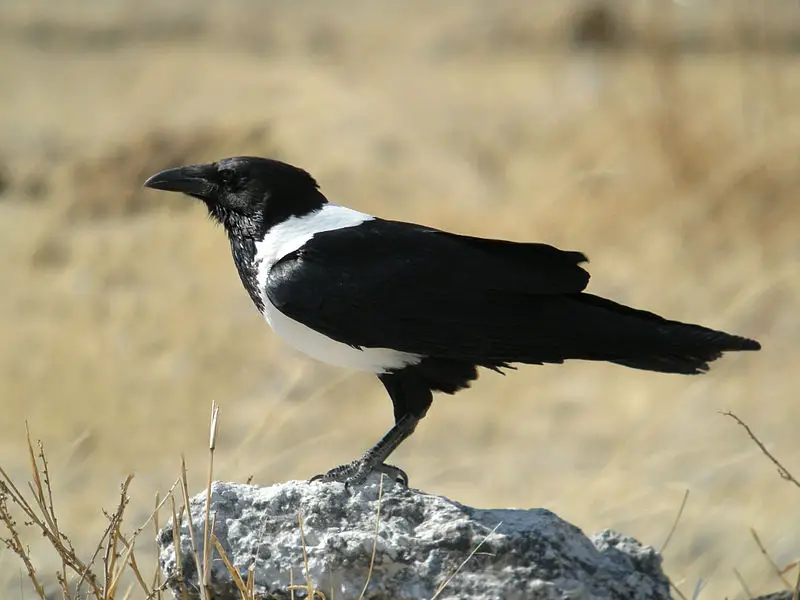
The Pied Crow is an African bird species belonging to the crow genus. It has a very wide range and its size lies somewhere between that of a typical crow and raven, making it more like the latter in terms of structure.
Its behaviour however, leans towards that of carrion crows from Eurasia – suggesting that it may be a modern link between them both.
The pied crow can hybridise with Somali Crows (dwarf ravens) where their ranges intersect in Horn Africa.
This species is known for being adaptable yet shy around humans and tend to keep away from urban areas if possible.Scientific classification:
| Kingdom | Animalia |
| Phylum | Chordata |
| Class | Aves |
| Order | Passeriformes |
| Family | Corvidae |
| Genus | Corvus |
| Species | C. albus |
Also Featured In: African Birds,
28. Pied Kingfisher
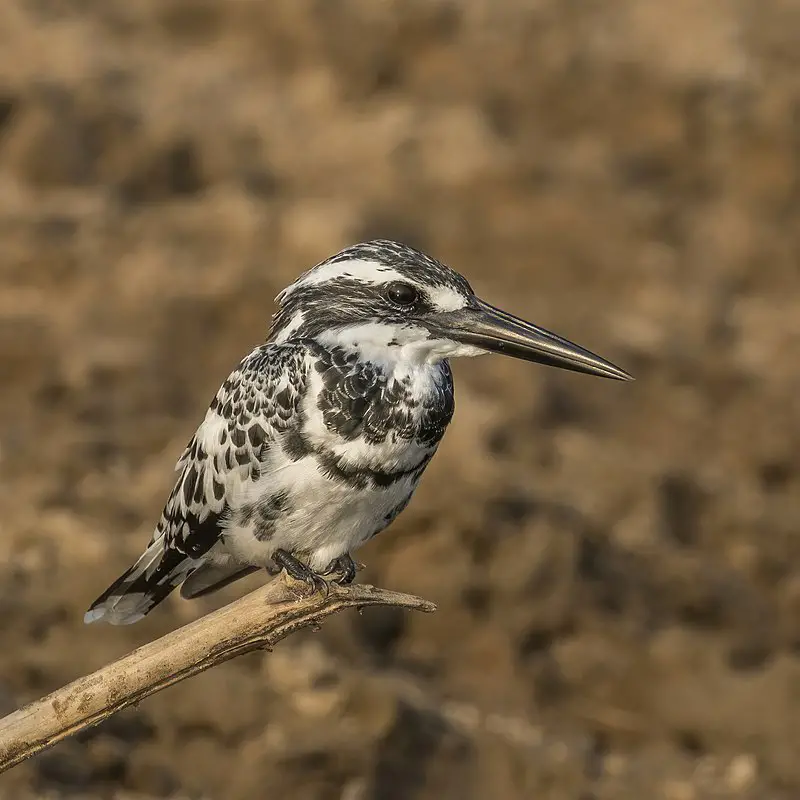
The Pied Kingfisher is a species of water kingfisher found in Africa and Asia. It has black and white plumage, with males sporting a double band across the breast while females have one single band.
This bird makes its presence known by hovering over clear waters before diving for fish – making it easily recognizable.
The diet consists mostly of small aquatic animals such as frogs, crustaceans and insects, but they also consume some plant matter like seeds or fruits occasionally.
The pied kingfisher nests near bodies of water where it can feed off smaller creatures that dwell there; usually in burrows dug into riverbanks or on floating vegetation close to shorelines.
With their distinct colors and behavior patterns these birds make an interesting addition to any wildlife enthusiast’s list.Scientific classification:
| Kingdom | Animalia |
| Phylum | Chordata |
| Class | Aves |
| Order | Coraciiformes |
| Family | Alcedinidae |
| Subfamily | Cerylinae |
| Genus | Ceryle F. Boie, 1828 |
| Species | C. rudis |
29. Beautiful Sunbird
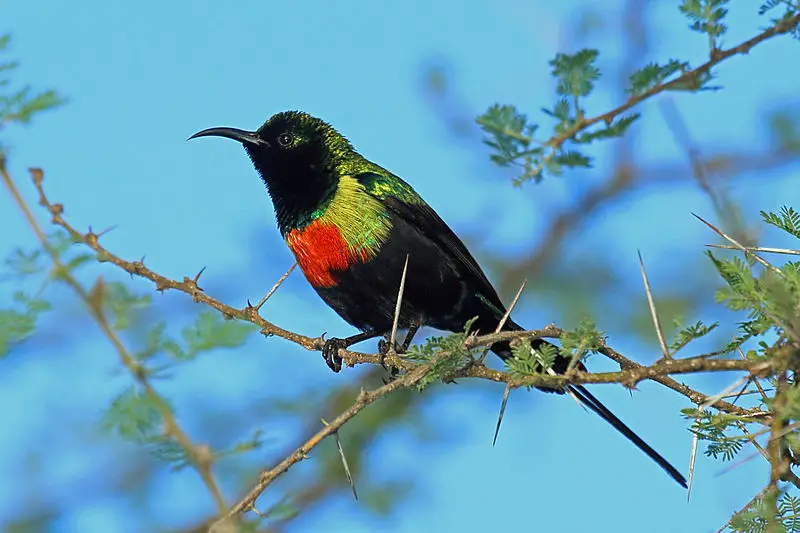
The Beautiful sunbird is a small and colorful bird, native to tropical Africa. It measures roughly 10 cm in length, with the breeding male’s long tail adding an extra 5 cm.
Its plumage has shades of yellow-green on its back and head, while its breast and belly are usually orange or red depending on their location.
These birds have thin down curved beaks that help them feed from flowers for nectar as well as insects like flies, moths, bees and beetles which they catch in midair with acrobatic tricks.
They typically live alone but during mating season form pairs and build nests out of grasses woven together using spider webs at the base of trees or shrubs close to water sources.
The males display vibrant colors when courting females by rapidly flicking their wings open then closed again before soaring away in flight.Scientific classification:
| Kingdom | Animalia |
| Phylum | Chordata |
| Class | Aves |
| Order | Passeriformes |
| Family | Nectariniidae |
| Genus | Cinnyris |
| Species | C. pulchellus |
30. White-Throated Bee-Eater
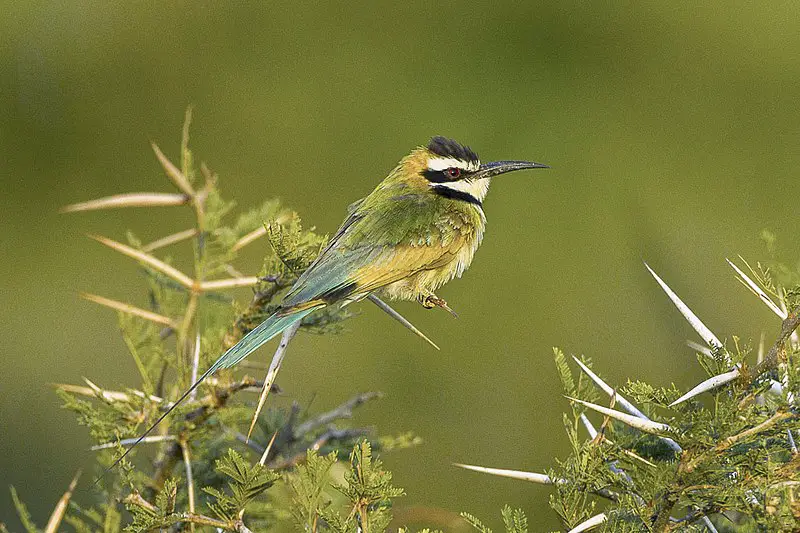
The White-throated bee-eater is a stunningly colourful bird that belongs to the Meropidae family in the near passerine category.
It breeds in semi-desert regions along southern Sahara and migrates during winter months to equatorial rain forests from Senegal to Uganda, where it enjoys different habitat experiences.
Its plumage consists of bright blues, greens and yellows with a distinctive white throat patch which gives it its name.
They feed on insects such as bees, dragonflies and wasps by catching them mid flight or plucking them off vegetation before returning back to their perch spot for eating; they perform aerial acrobatics while hunting.
These birds are social creatures who form colonies when breeding season arrives around springtime.
Their nests consist of tunnels dug up into sandy banks or termite mounds lined with grasses providing protection against predators like snakes and monitor lizards making this species an excellent example of adaptation in nature.Scientific classification:
| Kingdom | Animalia |
| Phylum | Chordata |
| Class | Aves |
| Order | Coraciiformes |
| Family | Meropidae |
| Genus | Merops |
| Species | M. albicollis |
31. Abyssinian Roller
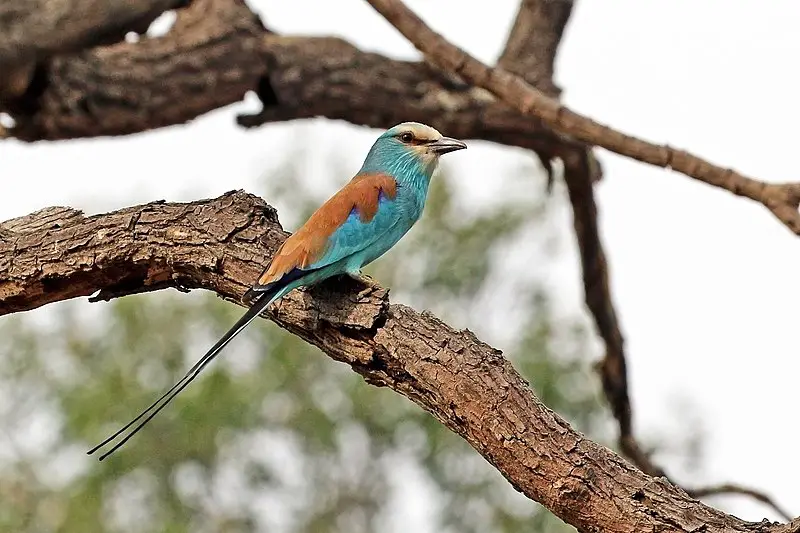
The Abyssinian roller is a large bird, nearly 28 cm in length. It has an unmistakable plumage of bright blue upperparts with chestnut underparts and wings.
Its head is blackish-blue and its tail feathers are white tipped giving it a striking appearance when seen in flight.
This species breeds across tropical Africa from the Sahel belt south of the Sahara desert to East Africa.
Northern populations tend to migrate short distances after wet season while southern ones stay resident throughout year.
They feed mainly on insects which they catch by hovering over fields or open woodland before diving down onto their prey below them.
In addition, they also eat small reptiles, amphibians and rodents along with fruits such as figs occasionally too.Scientific classification:
| Kingdom | Animalia |
| Phylum | Chordata |
| Class | Aves |
| Order | Coraciiformes |
| Family | Coraciidae |
| Genus | Coracias |
| Species | C. abyssinicus |
32. Woodland Kingfisher
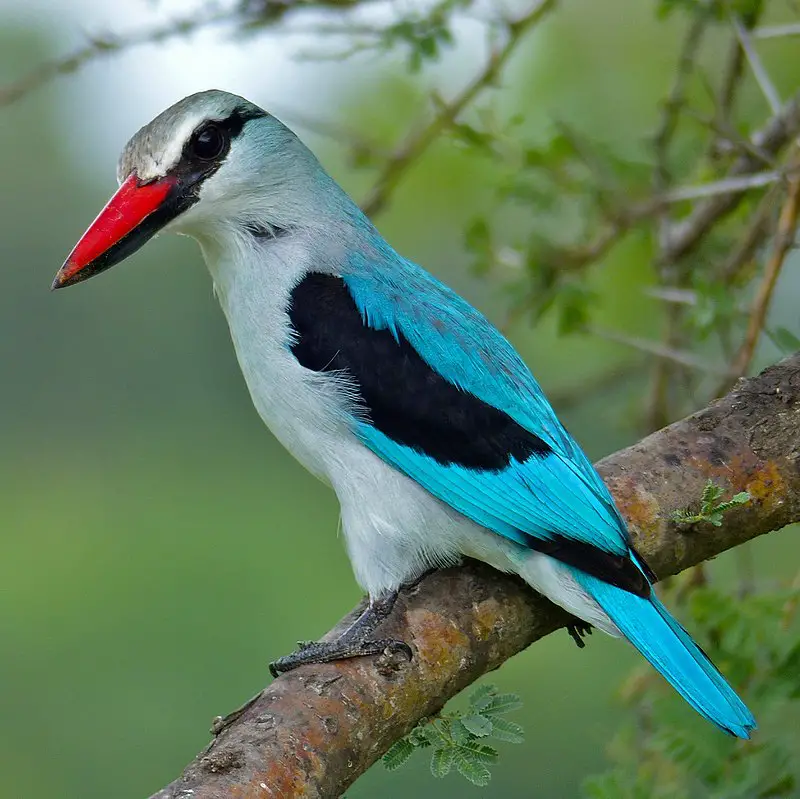
The Woodland Kingfisher is a beautiful bird, native to Africa south of the Sahara. It was first described in 1766 by Carl Linnaeus who called it Alcedo senegalensis.
This tree kingfisher has an attractive blue and white plumage with some red and black markings on its wings, tail and head.
The male also has a bright orange beak which helps to distinguish him from the female whose beak is yellowish-green.
These birds can usually be found in wooded areas near water sources such as rivers or lakes where they hunt for food including fish, frogs, small insects and even lizards.
They build their nests either high up in trees or inside holes dug out of banks near rivers and ponds.
Although not threatened yet, these lovely creatures need our protection so that future generations will have the chance to marvel at them too.Scientific classification:
| Kingdom | Animalia |
| Phylum | Chordata |
| Class | Aves |
| Order | Coraciiformes |
| Family | Alcedinidae |
| Subfamily | Halcyoninae |
| Genus | Halcyon |
| Species | H. senegalensis |
33. African Grey Hornbill
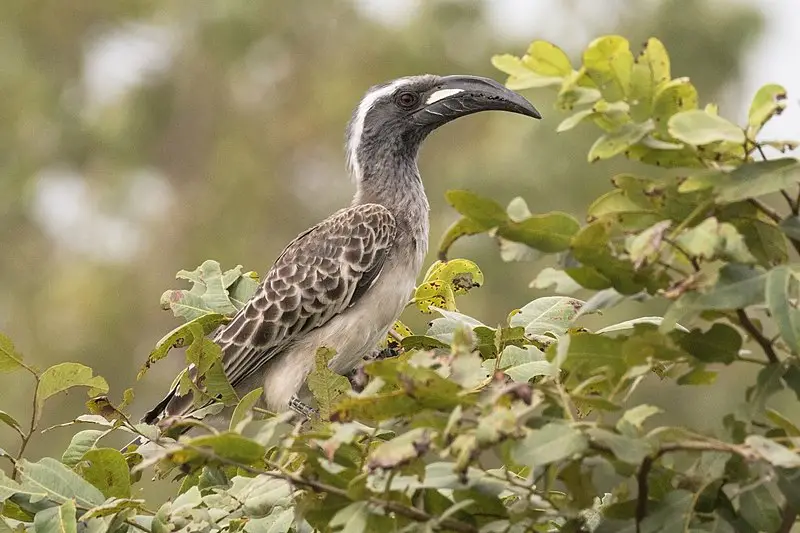
The African grey hornbill is a large bird with striking black and white plumage. Its most recognizable feature is its long, down-curved bill which has a red base and yellow tip.
They are found in sub-Saharan Africa as well as Arabia and have been known to escape or be released into Florida where they may not be breeding yet.
Their diet mainly consists of fruits, insects, small reptiles and amphibians making them important seed dispersers for their habitats.
Hornbills play an important role in the ecosystem by controlling pests like locusts while also providing food for predators such as eagles or larger cats.
These birds are often kept as pets but can become very demanding due to their intelligence so potential owners should do research before considering one of these amazing creatures.Scientific classification:
| Kingdom | Animalia |
| Phylum | Chordata |
| Class | Aves |
| Order | Bucerotiformes |
| Family | Bucerotidae |
| Genus | Lophoceros |
| Species | L. nasutus |
34. Red-Throated Bee-Eater
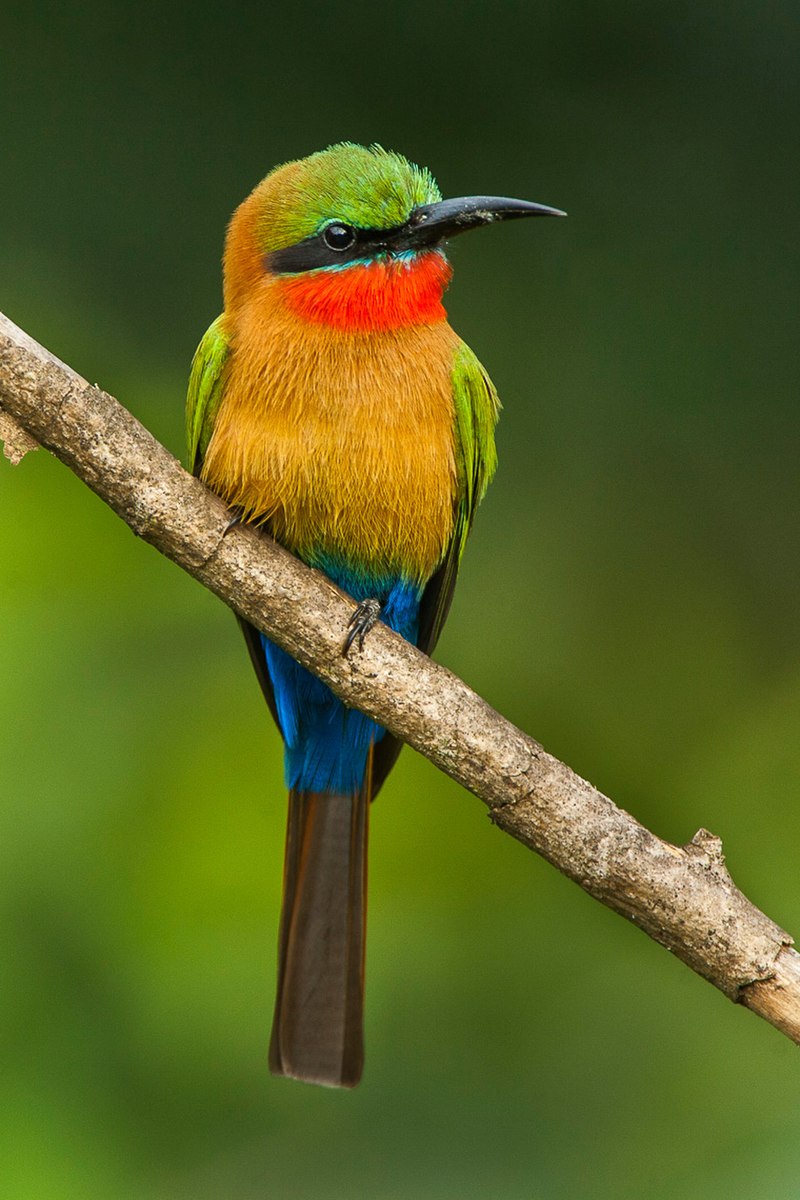
The Red-throated Bee-eater is a beautiful species of bird found in tropical Africa. It has bright red feathers covering its throat, giving it a distinct look.
Its body is mostly brown with white stripes and its wings are dark blue on the tips.
This species enjoys an extensive range throughout countries like Benin, Burkina Faso, and Togo to name just a few.
These birds feed mainly on insects that they catch in midair or from nearby foliage during their hunting flights over open country habitats such as woodlands and savannas.
While not much else is known about this particular type of bee-eater, these colorful creatures have surely become quite popular due to their striking beauty.Scientific classification:
| Kingdom | Animalia |
| Phylum | Chordata |
| Class | Aves |
| Order | Coraciiformes |
| Family | Meropidae |
| Genus | Merops |
| Species | M. bulocki |
35. African Paradise Flycatcher
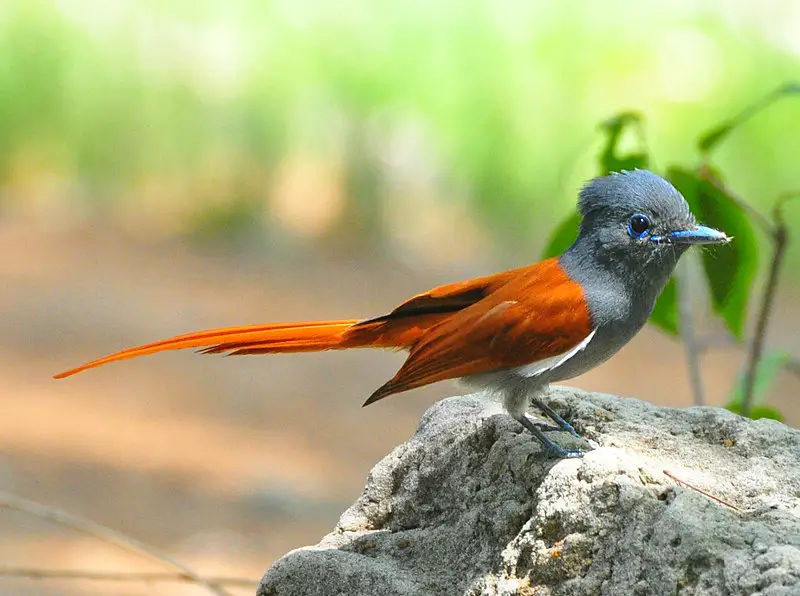
The African paradise flycatcher is a beautiful passerine bird, with the males having tail feathers that extend into streamers twice as long as its body.
Males have chestnut or rusty coloured upper parts on their wings and tails, contrasting nicely against the whitish underparts of both genders.
The head and throat are black for adult males, while females lack this colouration but feature some orange-red streaking instead.
Both sexes bear red eyes and blue-grey legs and feet to round out their appearance.
These birds mainly inhabit tropical forests throughout Sub-Saharan Africa where they feed primarily on insects such as beetles, ants, cicadas; occasionally supplementing it with small fruit when available during certain times of yearScientific classification:
| Kingdom | Animalia |
| Phylum | Chordata |
| Class | Aves |
| Order | Passeriformes |
| Family | Monarchidae |
| Genus | Terpsiphone |
| Species | T. viridis |
36. Pin-Tailed Whydah
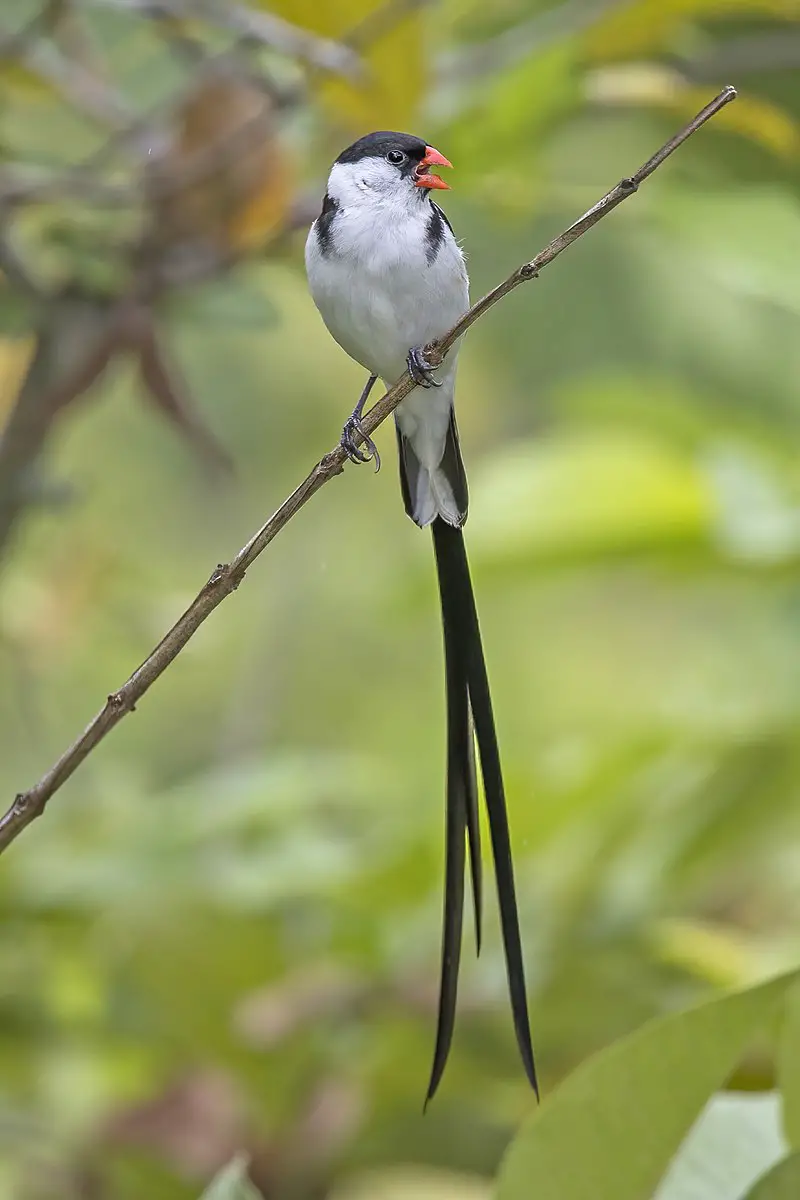
The Pin-tailed Whydah (Vidua macroura) is a small yet eye-catching songbird native to Africa, south of the Sahara Desert.
With breeding males sporting an impressive pennant-like tail, it measures in at 12–13 cm long and can be identified by its black plumage with white spots on wings and flanks.
It was first described by German naturalist Peter Simon Pallas back in 1764. The bird typically inhabits open savanna habitat where they feed mainly on grass seeds supplemented with insects during the rainy season.
During courtship displays, male birds will spread their tails while singing loudly from a perch or hover over females before mating takes place – making this one of nature’s most captivating spectacles.Scientific classification:
| Kingdom | Animalia |
| Phylum | Chordata |
| Class | Aves |
| Order | Passeriformes |
| Family | Viduidae |
| Genus | Vidua |
| Species | V. macroura |
Also Featured In: Birds that You’ll Find in Puerto Rico, Savanna Birds You Need to See
37. Village Weaver
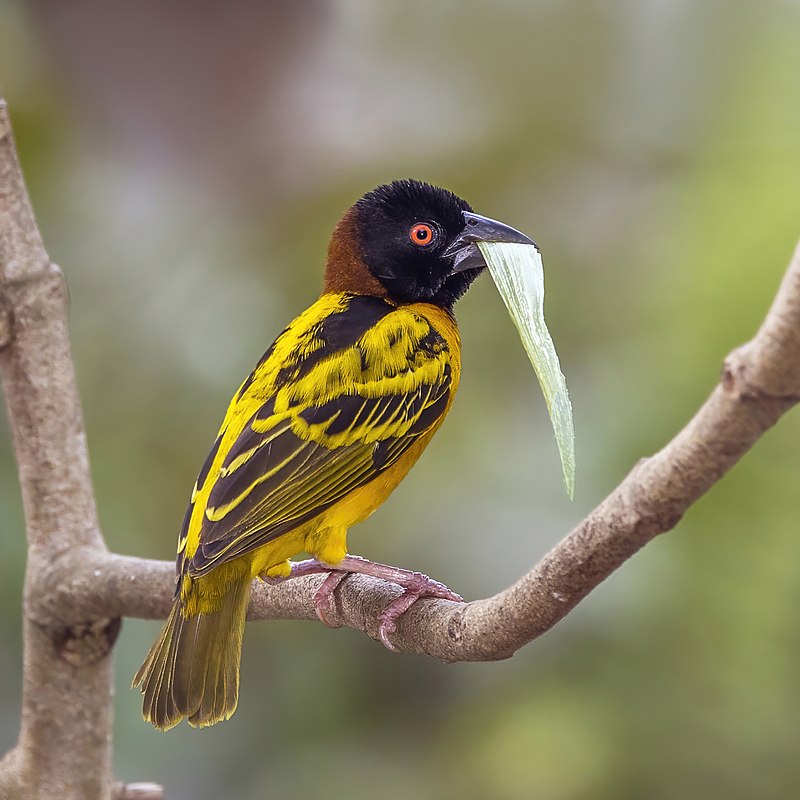
The Village Weaver is a bird found in sub-Saharan Africa, as well as on islands like Hispaniola and Martinique.
It has distinctive black heads with white spots on its back and wings.
They feed mainly on seeds but also eat some insects. The males build nests made of grasses that hang from branches or trees to attract mates during breeding season.
These birds are social creatures often seen in pairs or small groups foraging together in the same area.
Their calls are melodious chirps which can be heard throughout their range when they communicate danger or alert each other of food sources nearby.Scientific classification:
| Kingdom | Animalia |
| Phylum | Chordata |
| Class | Aves |
| Order | Passeriformes |
| Family | Ploceidae |
| Genus | Ploceus |
| Species | P. cucullatus |
38. Northern Red-Billed Hornbill
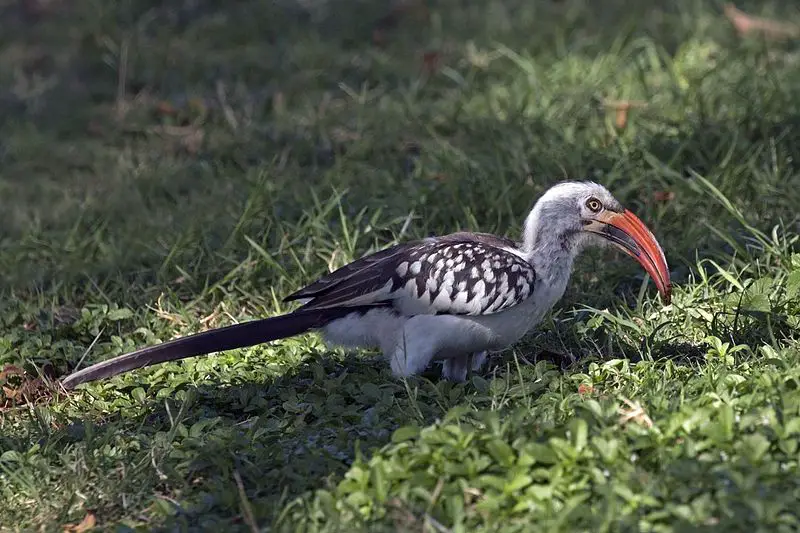
The Northern Red-billed Hornbill is a species of bird belonging to the Bucerotidae family. It can be found in many countries across Africa, from Mauritania through Somalia and Northeast Tanzania.
This hornbill has five recognized subspecies, though all were once considered part of one single species. The northern red-billed hornbill have distinctive black feathers on their body with deep yellow around its eyes and crest.
Its bill and legs are bright red while they feature an impressive casque at the top of it’s head that helps amplify calls during mating season or as a signifier for territoriality towards other birds.
They feed mainly on fruits such as figs but also enjoy insects like moths or beetles when available.Scientific classification:
| Kingdom | Animalia |
| Phylum | Chordata |
| Class | Aves |
| Order | Bucerotiformes |
| Family | Bucerotidae |
| Genus | Tockus |
| Species | T. erythrorhynchus |
39. Red-Billed Firefinch
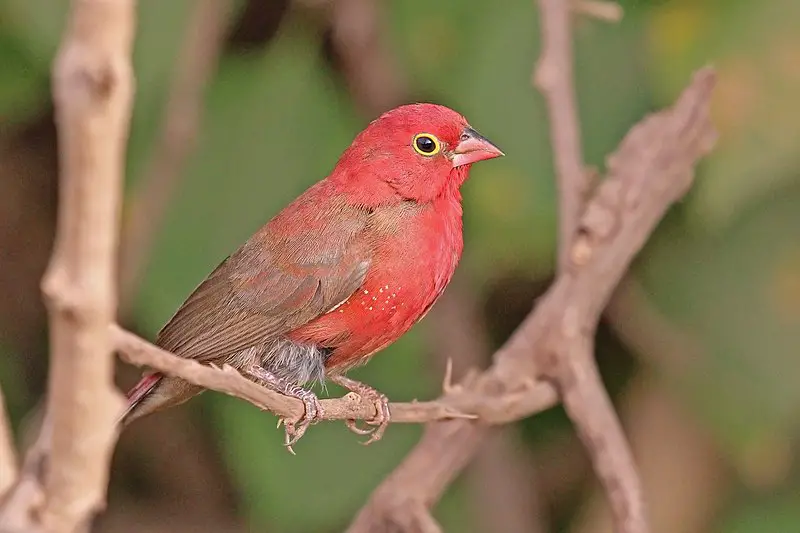
The Red-billed Firefinch is a small seed-eating bird native to sub-Saharan Africa. Its range spans an estimated 10 million square kilometers and it breeds year round in much of its habitat.
It has also been introduced, with mixed success, into both Egypt and southern Algeria where it continues to expand its population numbers.
The firefinch stands out from other birds with its bright colors – mostly black body plumage accented by red on the wings, tail feathers and most notably beak.
They are sociable creatures that can often be seen in flocks at waterholes or foraging together amongst vegetation for seeds.Scientific classification:
| Kingdom | Animalia |
| Phylum | Chordata |
| Class | Aves |
| Order | Passeriformes |
| Family | Estrildidae |
| Genus | Lagonosticta |
| Species | L. senegala |
40. Gull-Billed Tern
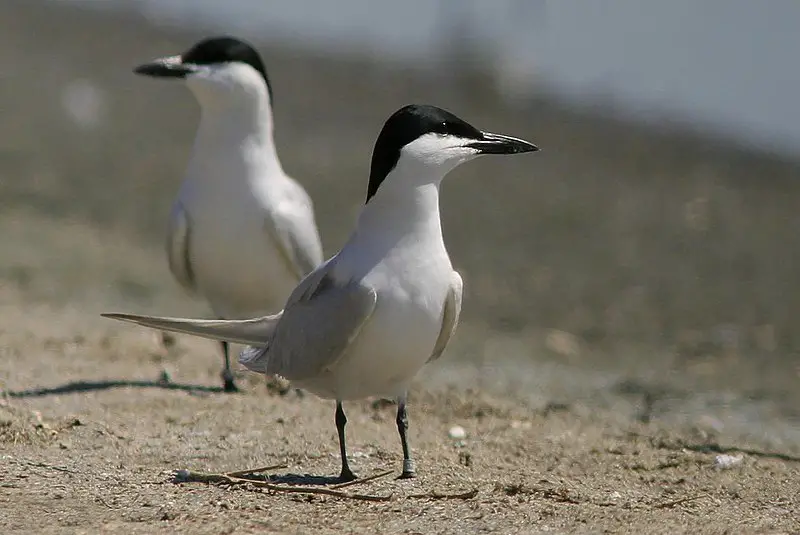
The Gull-billed Tern is a species of seabird from the Laridae family. It has an extensive range, breeding in parts of Europe, Asia, Northwest Africa and North America.
It was formally described by Johann Friedrich Gmelin in 1789 as Sterna nilotica before being reclassified to Gelochelidon nilotica.
The Australian subspecies was previously considered separate but now included with this species.
They are quite small birds measuring around 24 cm long with greyish brown upperparts throughout their body and white underneaths along with black legs and feet.
Their head also features a distinctive yellow bill which they use to hunt for fish on rivers or coasts near shallow waters where they tend to nest during summer months on ground level instead of trees like other terns do usually.Scientific classification:
| Kingdom | Animalia |
| Phylum | Chordata |
| Class | Aves |
| Order | Charadriiformes |
| Family | Laridae |
| Genus | Gelochelidon |
| Species | G. nilotica |
41. Little Egret
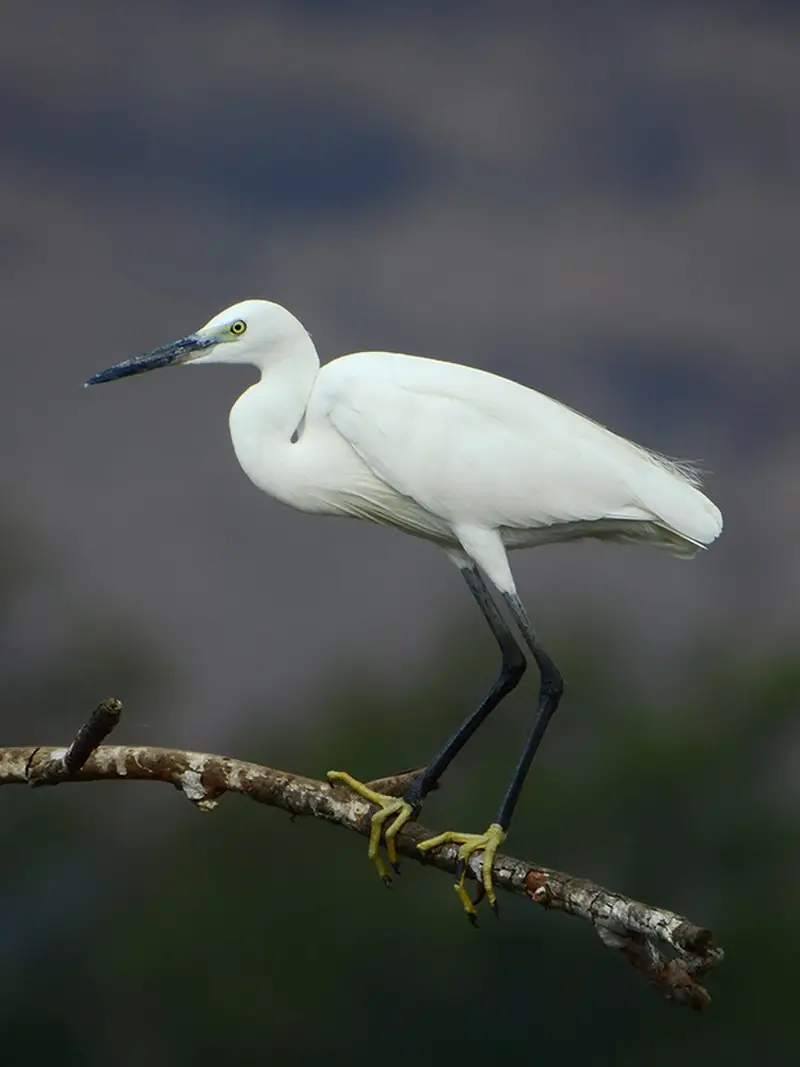
The Little Egret is a small white heron with sleek black beak, long black legs and in some cases yellow feet.
It can be found near aquatic areas where it feeds on molluscs, amphibians and insects while also occasionally feeding of land creatures such as lizards or rodents.
Breeding seasonally they make platform nests of sticks being built either by themselves or in colonies alongside other water birds.
They are widely distributed across the world from Europe to Africa, Asia to Australia making them an easily recognisable bird species often seen at waterside locations searching for their next meal.Scientific classification:
| Kingdom | Animalia |
| Phylum | Chordata |
| Class | Aves |
| Order | Pelecaniformes |
| Family | Ardeidae |
| Genus | Egretta |
| Species | E. garzetta |
42. Black-Winged Stilt
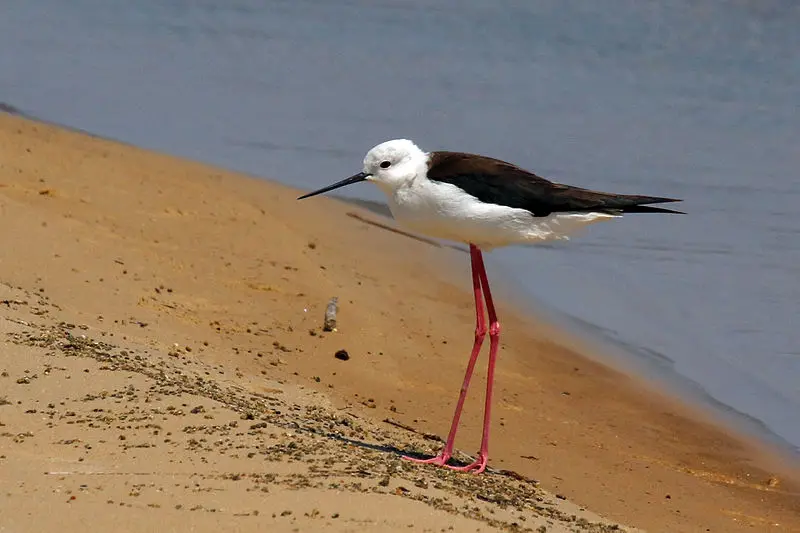
The Black-winged Stilt is a wading bird that belongs to the avocet and stilt family. It has very long legs, making it well adapted for standing in shallow water while searching for food like small fish and insects.
Its scientific name Himantopus himantopus can be applied either to one cosmopolitan species or the form found across Europe, Asia and Africa which equals its nominate group.
Generally this species is black on top with an all white underside but it also features red eyes with a thin white ring around each one as well as black wings flecked with white feathers towards the tips of their wings.Scientific classification:
| Kingdom | Animalia |
| Phylum | Chordata |
| Class | Aves |
| Order | Charadriiformes |
| Family | Recurvirostridae |
| Genus | Himantopus |
| Species | H. himantopus |
Also Featured In: Turkey Birds You Should Know, Ukrainian Birds You Should Know
43. Pink-Backed Pelican
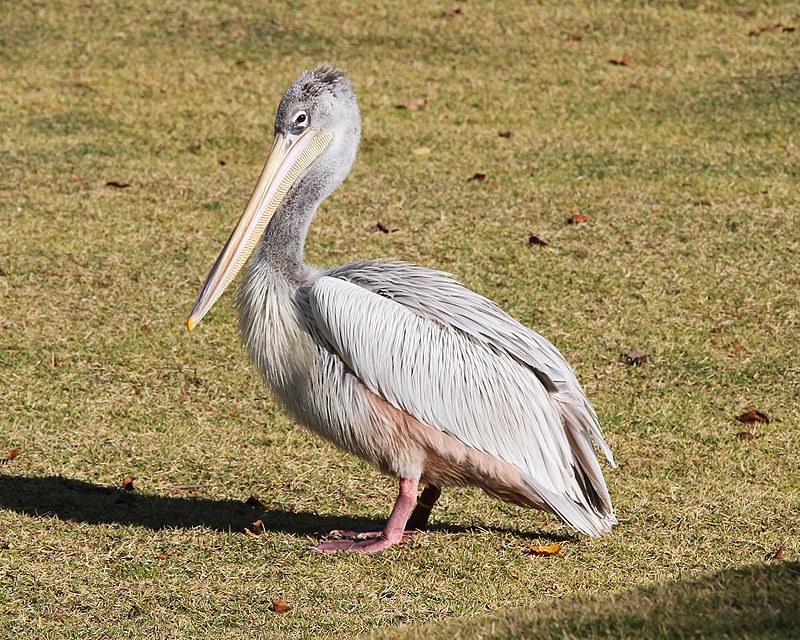
The Pink-backed Pelican is a beautiful bird of the pelican family, found in Africa and southern Arabia.
They are resident breeders that inhabit swamps and shallow lakes, but were once seen in Madagascar as well.
It was formally described by German naturalist Johann Friedrich Gmelin back in 1789.
These birds have unique pink feathers on their backs which gives them their name along with grey or white heads with black wing tips.
They use their long beaks to scoop up fish from the water then drain out excess water before swallowing it whole.
The diet of these birds consists mainly of small fish like anchovies, sardines, and other types offish they can find near the surface of rivers or lakes.
With its long wingspan ranging between 2 – 3 feet (60 – 90 cm), this species has adapted perfectly for gliding over bodies of water while searching for prey to eat.Scientific classification:
| Kingdom | Animalia |
| Phylum | Chordata |
| Class | Aves |
| Order | Pelecaniformes |
| Family | Pelecanidae |
| Genus | Pelecanus |
| Species | P. rufescens |
44. Double-Spurred Spurfowl
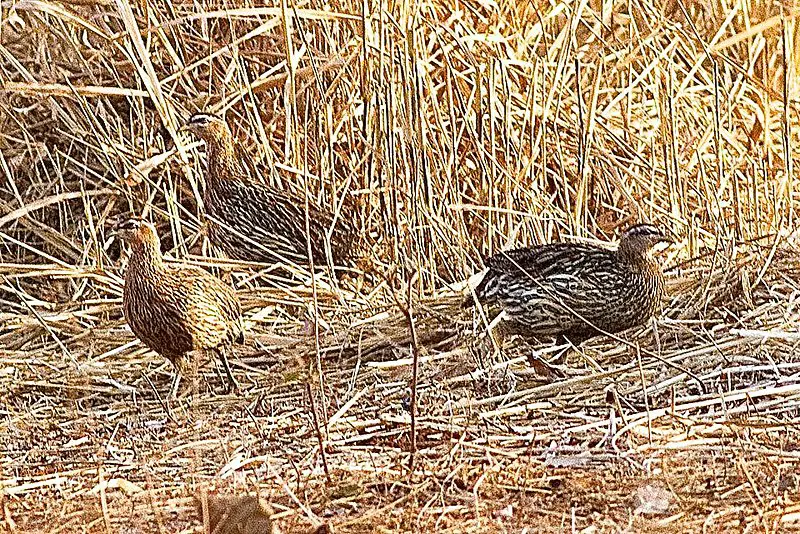
The Double-spurred Spurfowl is a gamebird of the Phasianidae family and belongs to the order Galliformes. It can be found in tropical West Africa, as well as an isolated population in Morocco which is decreasing due to human activity.
In 1760 Mathurin Jacques Brisson described it for the first time with its distinctive double spurs on each leg used during mating displays.
The bird has overall brown coloration but features black stripes along its sides and chest, while having white spots scattered across feathers too.
Its legs are long and thick enabling them to run quickly when escaping predators or searching for food such as insects, seeds or fruits that make up their diet.
These birds form monogamous pairs who defend territories fiercely against intruders all year round whether other spurfowls or humans encroaching into their habitats directly threatening conservation efforts being made by organisations around the world today.Scientific classification:
| Kingdom | Animalia |
| Phylum | Chordata |
| Class | Aves |
| Order | Galliformes |
| Family | Phasianidae |
| Genus | Pternistis |
| Species | P. bicalcaratus |
45. Western Reef Heron
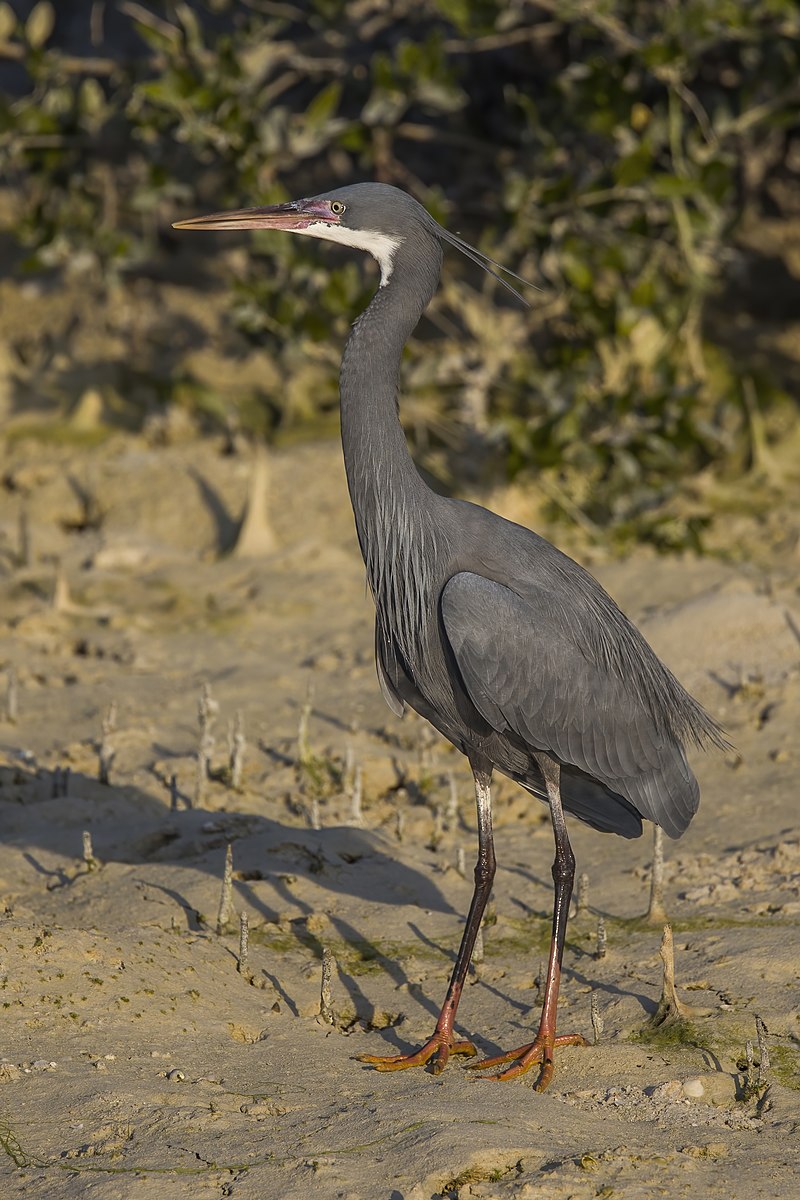
The western reef heron, also known as the western reef egret, is a medium-sized bird found in southern Europe, Africa and some parts of Asia. It usually inhabits coastal areas and has two distinctive plumage forms.
The slaty-grey form can be mistaken for the rare dark morph of the Little Egret while its white form looks similar to that of an immature Grey Heron.
This species feeds mainly on fish but will occasionally eat insects or other small aquatic animals like crabs and molluscs too.
Western Reef Herons are solitary birds that nest near water bodies where they build nests from sticks which may sometimes contain feathers or seaweed as well.
They have become endangered since their habitats have been destroyed due to human activities such as building developments along coastlines; however conservation efforts are being taken to ensure their survival into future generations.Scientific classification:
| Kingdom | Animalia |
| Phylum | Chordata |
| Class | Aves |
| Order | Pelecaniformes |
| Family | Ardeidae |
| Genus | Egretta |
| Species | E. gularis |
Also Featured In: Birds that Live in Benin, Birds of Karnataka
46. Malachite Kingfisher
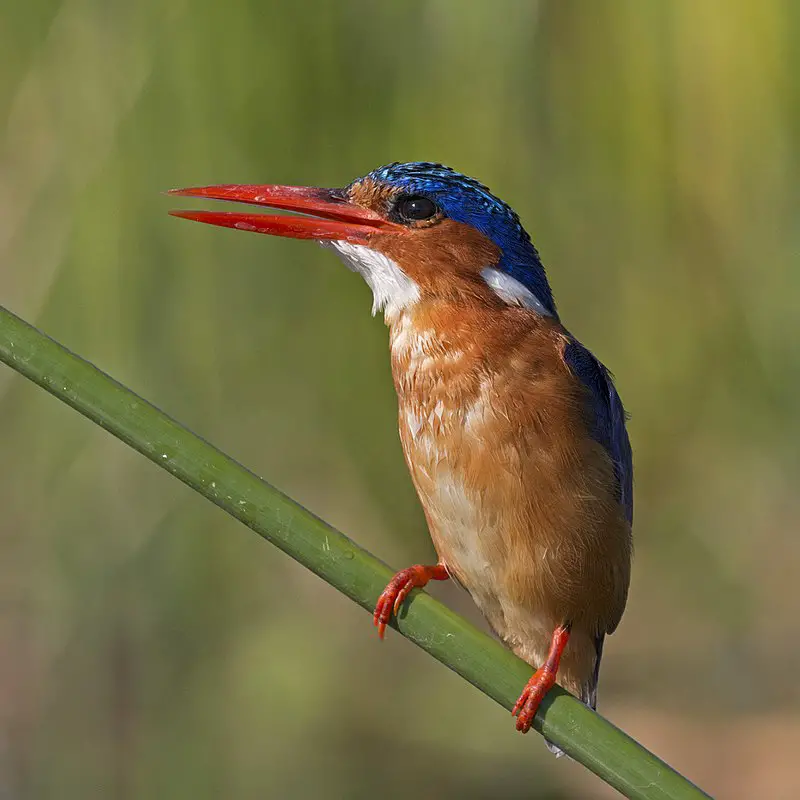
The Malachite Kingfisher is a beautiful bird found in Africa south of the Sahara. It has bright blue wings and tail, with greenish-black upperparts, white chin and breast and orange lower belly.
The species was first described by German naturalist Peter Simon Pallas in 1764 who gave it its binomial name “Alcedo cristata”.
This kingfisher typically inhabits rivers where it feeds on fish, frogs as well as aquatic invertebrates like crustaceans and insects.
Although mainly resident throughout the year, some do make seasonal movements due to climate changes.
These birds are monogamous during breeding season which usually lasts from August till October when they build their nests inside river banks or overhanging vegetation near water bodies.Scientific classification:
| Kingdom | Animalia |
| Phylum | Chordata |
| Class | Aves |
| Order | Coraciiformes |
| Family | Alcedinidae |
| Subfamily | Alcedininae |
| Genus | Corythornis |
| Species | C. cristatus |
47. Grey-Headed Gull
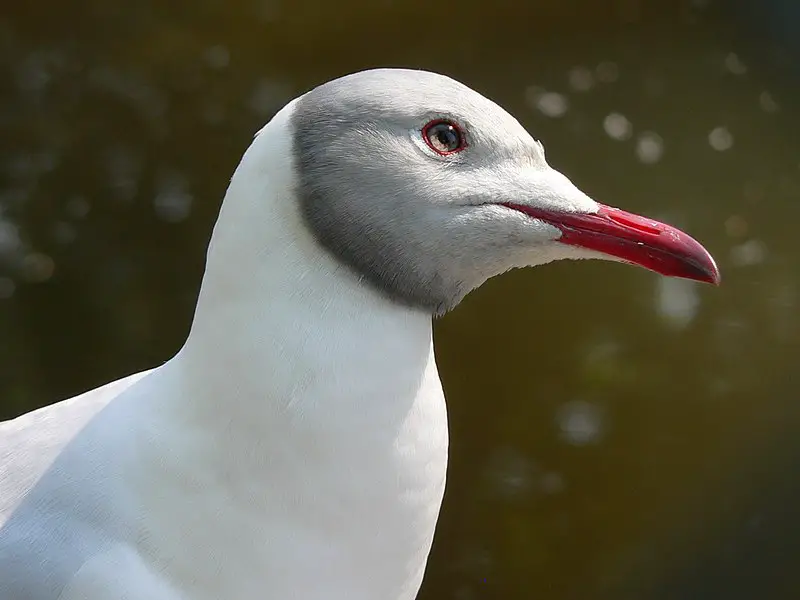
The Grey-headed Gull is a small species of gull that breeds patchily in South America and Africa south of the Sahara.
It has grey feathers on its head and wings, while its body is white with some brown spots near the tail.
This bird can be seen around coasts or inland lakes during winter times when it becomes more widespread.
Although not truly migratory, there have been rare cases where this species was recorded as a vagrant to North America, Italy and Spain.
The diet of these birds consists mainly of fish but also invertebrates such as mollusks, crustaceans and insects.
They usually forage alone or in pairs along shorelines looking for food items by probing mudflats or even stealing from other birds at times.Scientific classification:
| Kingdom | Animalia |
| Phylum | Chordata |
| Class | Aves |
| Order | Charadriiformes |
| Family | Laridae |
| Genus | Chroicocephalus |
| Species | C. cirrocephalus |
Also Featured In: Birds that You’ll Find in Kruger national park, Birds That Live around Gull Rock
48. African Pied Hornbill
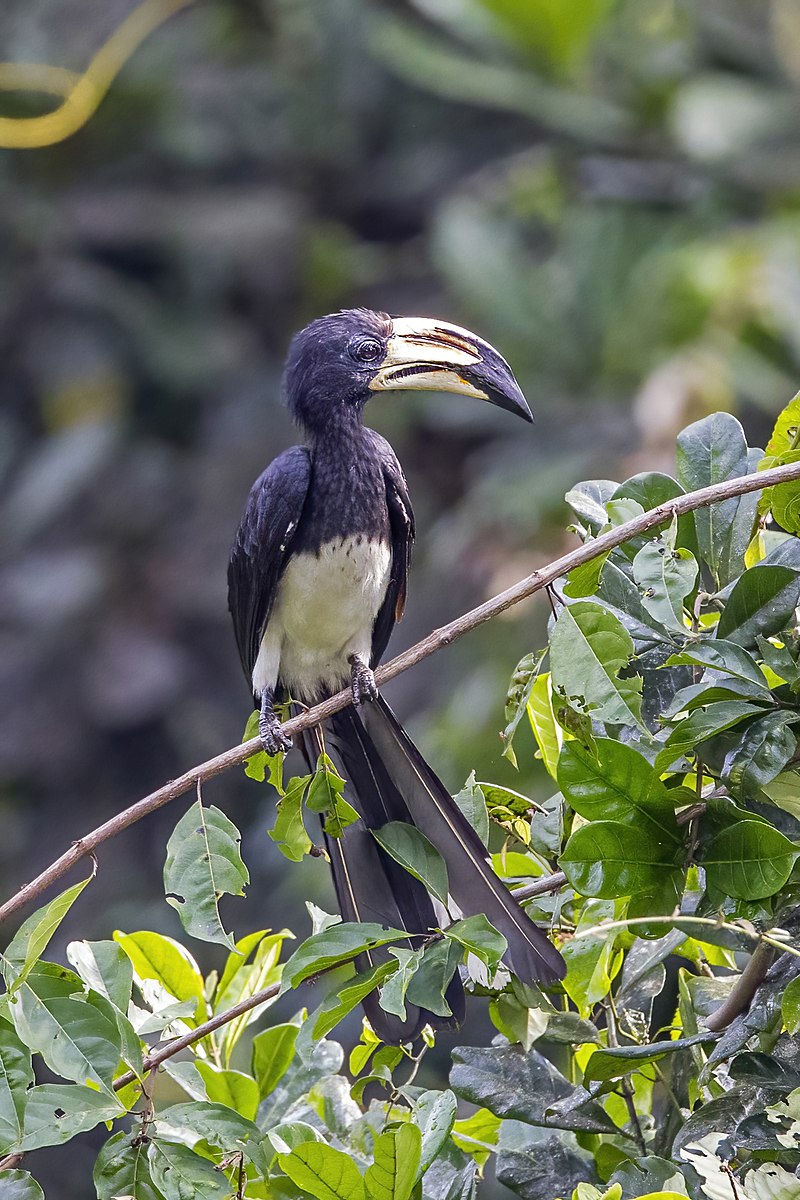
The African pied hornbill is a beautiful bird belonging to the family of tropical near-passerine birds found in the Old World.
It is widely distributed across equatorial Africa, ranging from The Gambia to western Uganda and northern Angola.
This species prefers habitats with plenty of trees for it to nestle in and make its home.
When breeding season arrives, females lay up to four white eggs inside tree holes that are sealed off by the males using mud or other materials as part of their nesting ritual.
These magnificent creatures have distinctive features such as black feathers on their bodies contrasted against bright yellow eyes and strikingly long beaks which they use mainly for eating fruit but also insects too.
They are an important part of African ecosystems and should be protected at all costs so future generations can continue appreciating these majestic birds.Scientific classification:
| Kingdom | Animalia |
| Phylum | Chordata |
| Class | Aves |
| Order | Bucerotiformes |
| Family | Bucerotidae |
| Genus | Lophoceros |
| Species | L. fasciatus |
49. Black Sparrowhawk
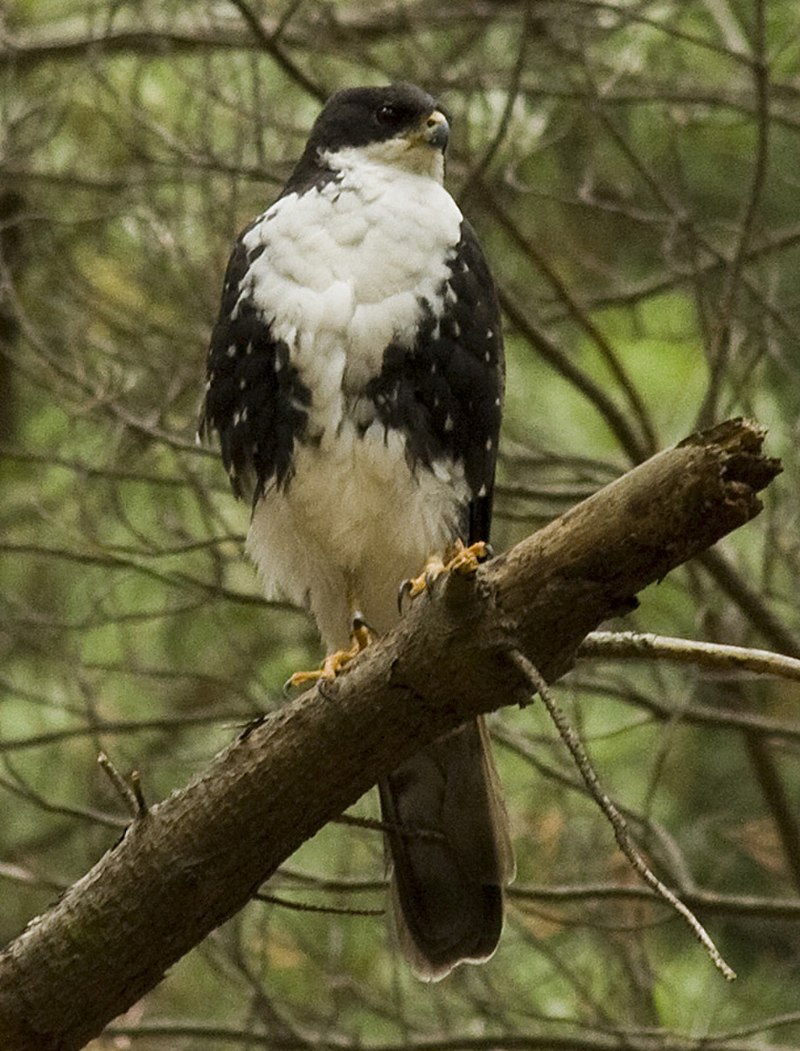
The Black Sparrowhawk is a majestic bird of prey native to Africa. It has distinct black and white feathers, with a light gray head and wings. The body length ranges from 30-44 cm (12-17 inches).
This impressive species can be found in forests, non-desert regions south of the Sahara Desert, as well as suburban areas with large trees suitable for nesting. They mainly feed on birds such as doves and pigeons but will also consume rodents or insects when necessary.
Its powerful talons are used to capture its unsuspecting victims while it glides gracefully through the air. These remarkable birds have an important role within their environment – they help maintain balance by controlling populations of other animals that could otherwise overpopulate if left unchecked.Scientific classification:
| Kingdom | Animalia |
| Phylum | Chordata |
| Class | Aves |
| Order | Accipitriformes |
| Family | Accipitridae |
| Genus | Accipiter |
| Species | A. melanoleucus |
50. Little Green Woodpecker
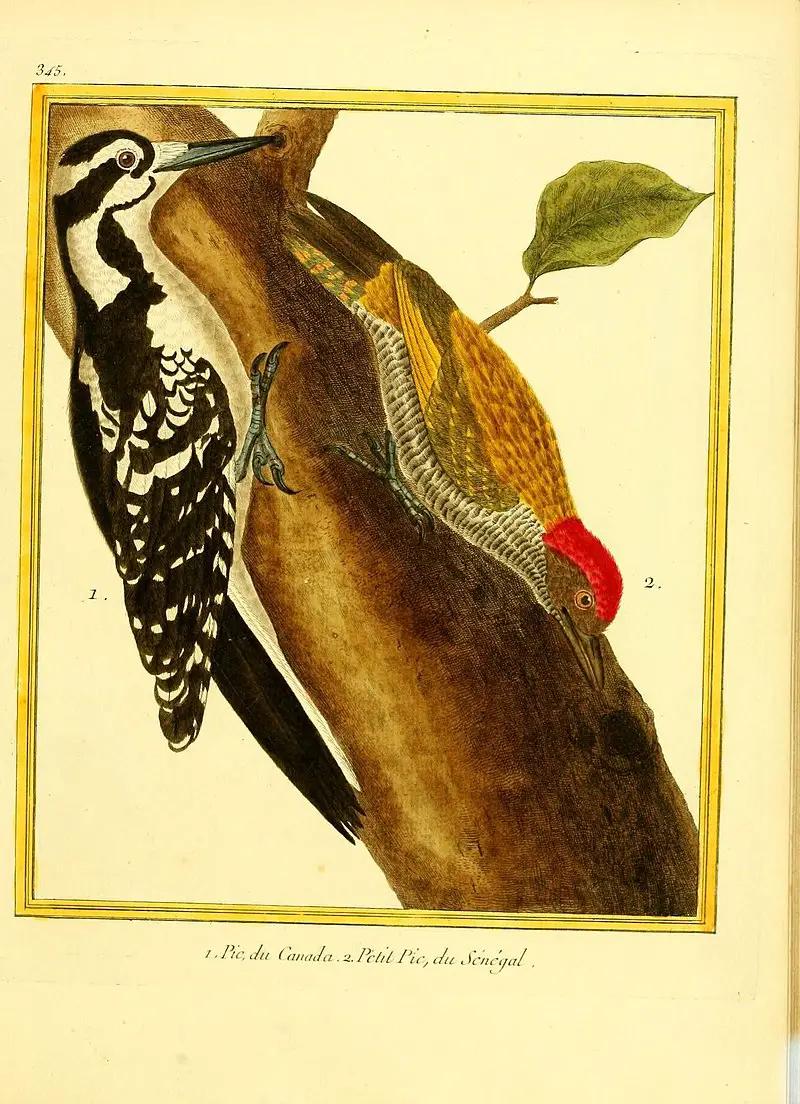
The Little green woodpecker, also known as the golden-backed woodpecker is a small bird that can be found in Africa. It lives along forest edges, clearings and even in areas with mixed forests and shrubbery.
This species was first described by Achille Valenciennes in 1826 and it has been assessed to be of least concern when it comes to conservation status according to the International Union for Conservation of Nature (IUCN).
The little green woodpeckers are very active birds who use their strong bills for pecking on trees or other hard surfaces. They feed mainly on insects like ants, beetles but they will also eat some fruits too.
These colourful birds often have striped wings with white spots which makes them stand out from other woodland creatures.
All in all, these amazing animals make a great addition to any African landscape.Scientific classification:
| Kingdom | Animalia |
| Phylum | Chordata |
| Class | Aves |
| Order | Piciformes |
| Family | Picidae |
| Genus | Campethera |
| Species | C. maculosa |